- Skip to primary navigation
- Skip to main content
- Skip to primary sidebar
- Skip to footer

Halfway Anywhere

The Tour Divide: What, Where, Why, and How?
By Mac Leave a Comment
The Tour Divide is an annual 2,700-mile (4,300 km) self-supported bikepacking race following the Great Divide Mountain Bike Route (GDMBR). Most of the route follows dirt and gravel roads with a few sections of pavement or singletrack sprinkled in for good measure (along with the occasional hike-a-bike section).
Cursory internet sleuthing tells me that the current iteration of the Tour Divide began in 2008. However, the first individual time trial of the route was in 2005, and people have been riding the GDMBR since as early as 1997 when the Adventure Cycling Association first mapped it.
Speaking of websites, the current Tour Divide website hasn’t been updated since 2014 and leaves much to be desired. Or perhaps the state of the website is instead part of the Tour Divide’s charm? Mystique? Neato-ness?
You may already have more questions than answers if you’ve encountered this with zero knowledge of the Tour Divide or the GDMBR. Fear not; they will be addressed. Also, know that I will likely have many of the same questions. I intend to answer said questions by participating in (and hopefully completing) this year’s Tour Divide.
That said, I’ve been doing my research (and investing heavily in bikepacking gear).
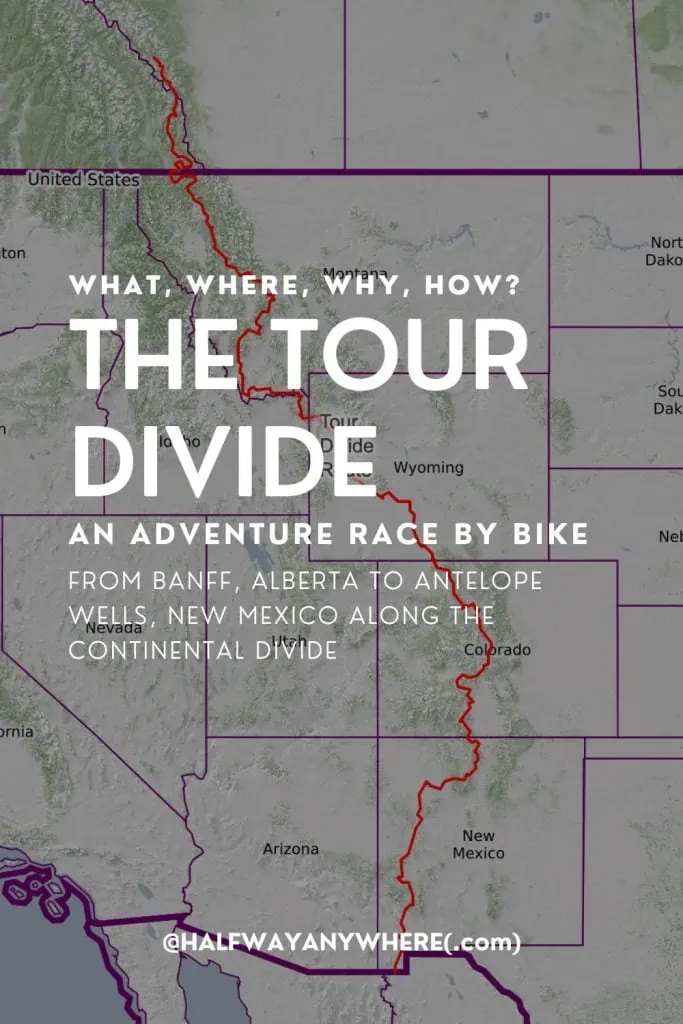
What Is the Great Divide Mountain Bike Route?
The northern terminus of the Great Divide Mountain Bike Route (GDMBR) is in Jasper (it was in Banff – the start of the Tour Divide – until 2018), a resort town in Alberta, Canada. It then heads south for over 3,000 mi / 4,800 km to its southern terminus at the US-Mexico Border at Antelope Wells, New Mexico. It can be ridden in either direction, but it’s traditionally ridden southbound.
Along with the Arizona Trail and the Colorado Trail, it comprises the most significant leg of bikepacking’s Triple Crown; similar to the thru-hiking Triple Crown comprised of the Pacific Crest Trail , Continental Divide Trail , and Appalachian Trail .
The route is almost entirely along dirt and gravel roads and is, for the most part, not a technical ride (i.e., you don’t need to be an expert-level mountain biker to navigate the GDMBR). Yes, there are a few short sections of singletrack, but overall, this route is suited for gravel or mountain bikes (but certainly not road bikes).
The GDMBR is approximately 3,000 mi / 4,800 km long and has over 133,000 ft / 40,500 m of climbing and an equal amount of descent. It passes through seven states/provinces: Alberta, British Columbia, Montana, Idaho, Wyoming, Colorado, and New Mexico. Despite beginning in Canada (as in riders must pass immigration at a border crossing), the route does not enter Mexico; it ends (or begins) at the US-Mexico Border.
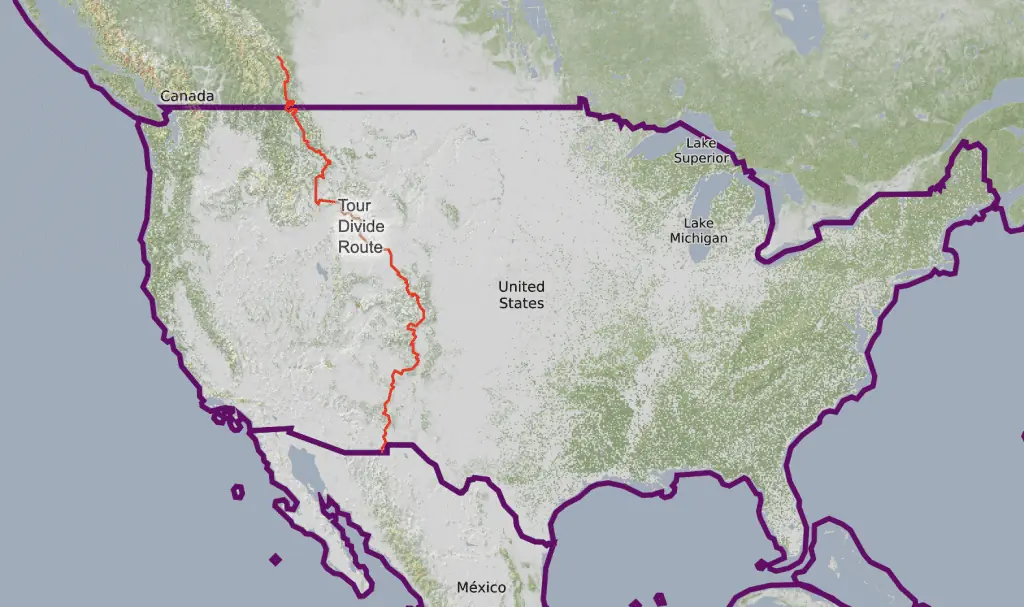
The Difference Between the Tour Divide and the GDMBR
You may be asking yourself, as I have, what’s the difference between the Tour Divide and the Great Divide Mountain Bike Route? The answer? Nothing. Kind of.
The Tour Divide is the name of the annual self-supported race of the GDMBR . Put another way, the Tour Divide follows the GDMBR. However, it begins in Banff instead of Jasper; Banff was the northern terminus of the GDMBR until 2018, when it was moved to Jasper. At least, that’s all you need to know if you’re not racing and/or riding the Tour Divide. What’s self-supported? It means that racers are only afforded resources available to everyone else participating.
For example, staying at a hotel? Perfectly fine. Staying at a friend’s house? Not okay.
When you drill down to the details, there are a few sections where the Tour Divide diverges from the GDMBR. But for all intents and purposes, they’re the same; again, unless you’re concerned about racing the Tour Dviide, then there are a few spots you need to take note of.
Every year, people bikepack all or part of the GDMBR on their own (in both directions). These people can take as much or as little time as they like – many presumably even enjoy their experience. Meanwhile, others decide to race the Tour Divide beginning on the second Friday of June at the northern terminus in Banff, Alberta (in Canada). The latter group’s enjoyment often falls more heavily into the Type II (or even Type III) fun category.
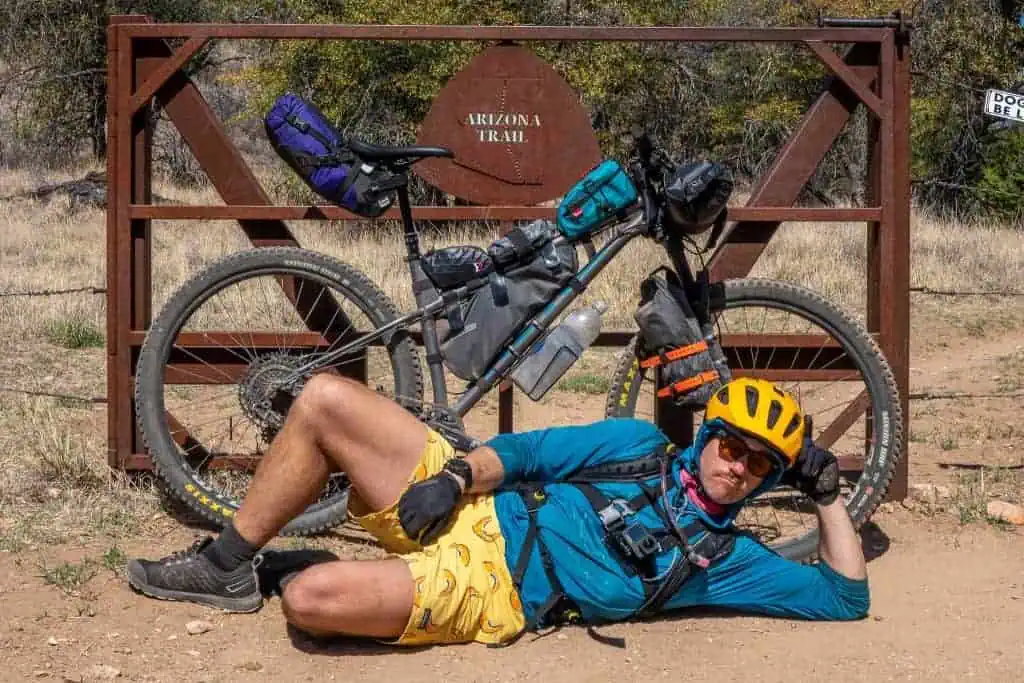
The GDMBR Versus the Continental Divide Trail
When I first hiked the Continental Divide Trail (CDT), I met one person in Island Park, Idaho, who was riding the Divide; I had no idea what they were doing, what the Tour Divide was, or what the GDMBR was. The cyclist was stoked to see me and my CDT hiking buddy, but we thought ourselves cooler than him because what could be cooler than hiking the CDT?
How things have changed. I apologize for not greeting you with the enthusiasm you deserved, anonymous 2017 Tour Divide racer.
Despite the CDT following a lot of dirt and gravel roads – that would be suitable for bikepacking – there’s actually very little overlap between the two routes. Yes, there will be opportunities for northbound CDT thru-hikers to see Tour Divide riders, but many will pass like ships in the night.
The Tour Divide starts too early for southbound CDT hikers to catch any riders, but they could still encounter northbound GDMBR riders during their thru-hikes. Remember, play nice if/when you see each other out there. We’re all out there doing awesome things in nature. There’s no need to perpetuate a bikepacker-backpacker divide (on the Divide).
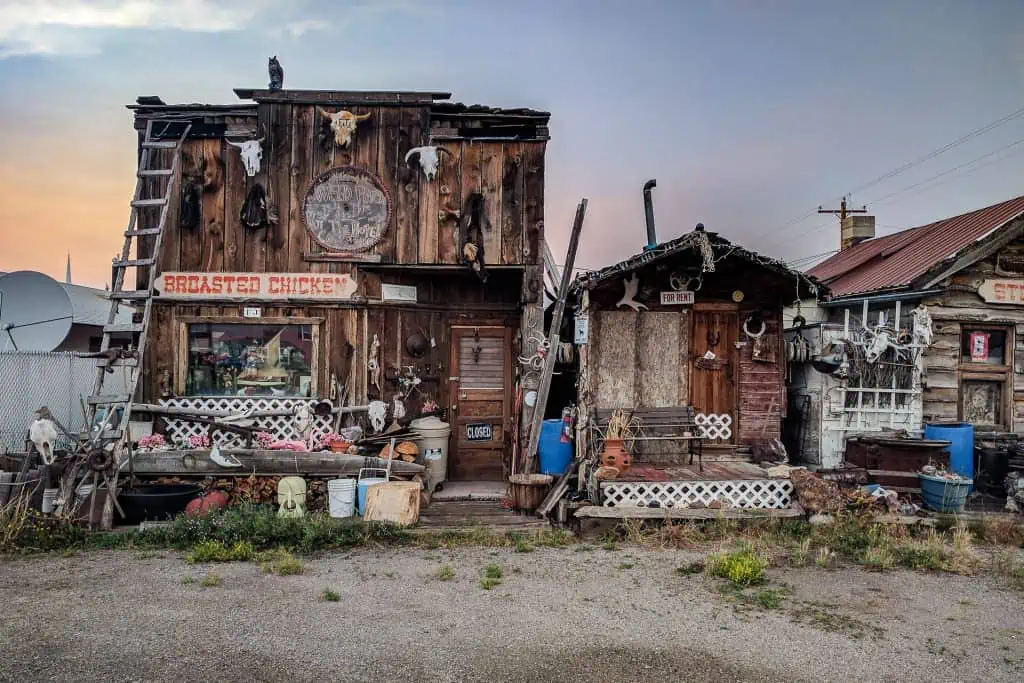
How to Participate in the Tour Divide
The community that has made the Tour Divide what it is today doesn’t exist as an official organization or entity. Instead, it’s willed into being by the yearly riding crop’s cohesion, carrying on traditions from and iterating upon actions of previous years’ cyclists.
There’s no sign-up form, no entry fee, no website (at least not a website updated in the last decade), and no organized event at the starting line in Banff (or at the finish line at Antelope Wells, New Mexico).
Most of the organization appears to come from Facebook groups (typically some of the most toxic online cesspools, but in rare cases, useful information corners). Every year, participants who provide tracking information (using a device such as a Garmin inReach Mini 2 ) to trackleaders can be watched online as they move down the course.
You show up in Banff, start riding south on the second Friday in June, tell anyone who asks that you’re riding the Tour Divide, and BOOM! you’re officially racing the Tour Divide. I’ve heard that in recent years that the community attempts to organize waves of riders (based on estimated finishing time) to ease impacts and congestion on/along the start of the race. Don’t want the local government to come in and try to shut down the unofficial race, after all.
Maybe one day, the magic of this unofficial, unorganized, organized, official bikepacking race will wane as permits, regulations, and rules are imposed with increasing popularity and awareness of the event. Maybe someone will write a best-selling book about the Tour Divide and blow it up like a certain unnamed book did to a certain unnamed trail in the Western United States.
Apparently, you’re supposed to send in a letter of intent to a random email address that I suspect is maintained by the crew at Bikepacking.com , but the letters of intent used to be posted to the Tour Divide website (which seems like it was a fun tradition that’s now sadly gone as of 2010).
For now, you only need to get on your bike and ride.
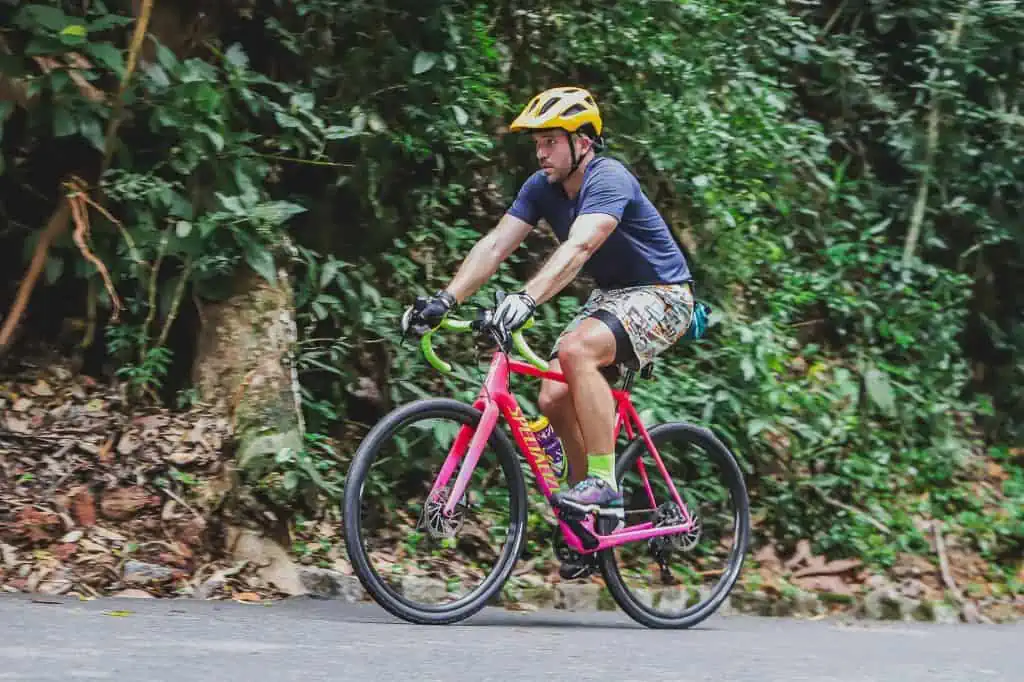
The Tour Divide is the unofficial orrifical self-supported race of the Great Divide Mountain Bike Route, with a few changes to the route. Simple enough, right?
It’s an incredible test of physical and mental endurance, with many riders forgoing sleep to put in more hours on the bike (how many hours I sleep every night is something I’m interested in seeing).
According to DotWatcher , since the Tour Divide’s conception in 2008, only 716 riders have completed the race (this number is likely not 100% accurate, but it’s about as good as we can do). Hopefully, after this year’s race, I will be able to count myself among the fewer than 1,000 total finishers.
For now, it’s time to go and ride my bike .
You'll Like These Too:
Share this post:.
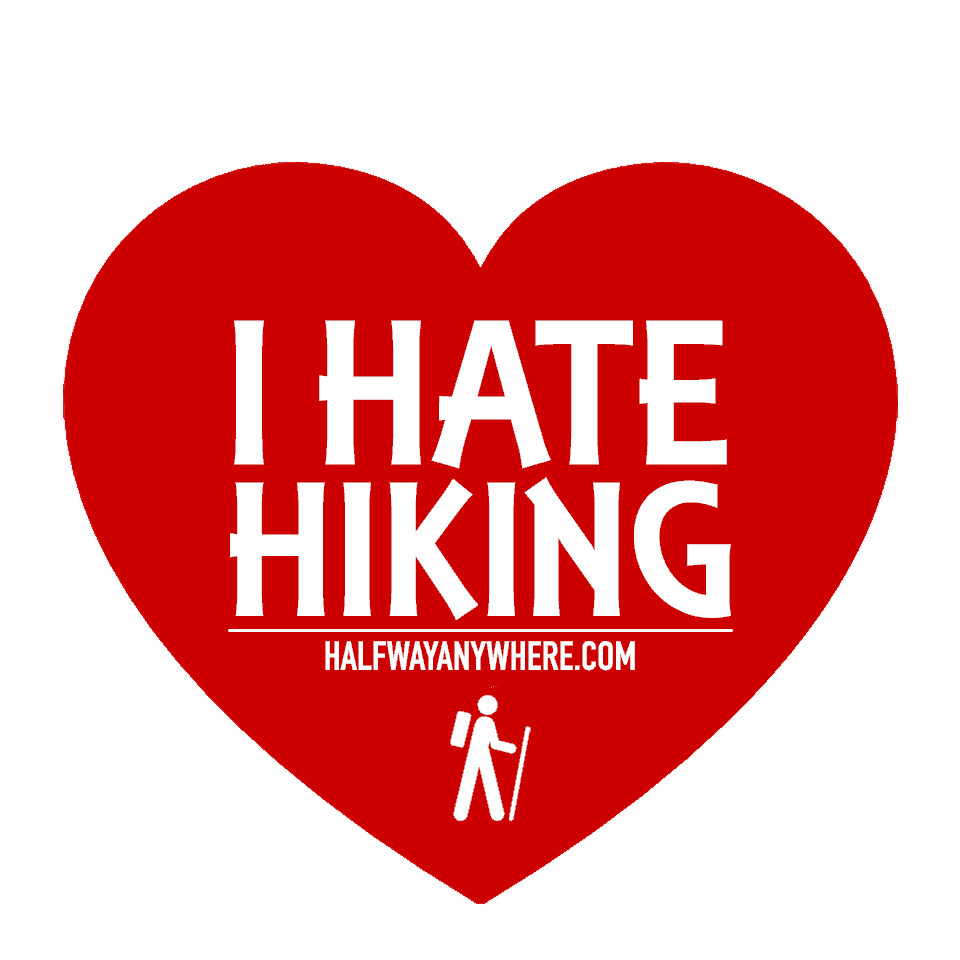

The Radavist
Reset Lightbox

Hide Thumbnails
Image gallery for:
Top fives along the great divide route: bike touring distilled.
By: Mitchell Connell May 14, 2023

As riders prepare for the 2023 Tour Divide Grand Depart, Mitchell Connell reflects on his time riding a section of the Divide with Baker Donahue and Will Reynolds, who were headed north from Antelope Wells, NM to Banff, Alberta. In this clever piece, Mitchell intersperses his retelling of the trip with the riders’ “top five” responses to a variety of prompts and, in doing so, distills down the meaningful aspects of a lengthy bike tour. What top five questions would you ask?
Do you ever read Thrasher ? Sometime last year, I was leafing through an issue from my friend’s coffee table when I came across an article on Breana Geering . The author asked her to list her top five answers to a variety of questions (top five things to worry about, pieces of advice you’d give to the 13-year-old you, etc.) and it stuck with me.
A year or so later, I was thinking about that article while riding along Grassy Lake Road on the Great Divide Mountain Bike Route. I was trying to keep up with Baker Donahue and Will Reynolds, who were both in better shape than I was. While that’s not unusual (both Will and Baker are typically super fit), it was particularly remarkable on this day because I’d started my ride in Jackson, Wyoming, some 40 miles earlier, and they both started in Antelope Wells, New Mexico and had covered about 1,700 miles before meeting up with me.

“Top five albums to descend to?”
- Sunami/Gulch Split , Sunami
- Come Away with ESG , ESG
- That new Maggie Rogers single on repeat
- Afrique Victime , Mdou Moctar
- IV , Led Zeppelin
The Great Divide Mountain Bike Route probably needs no introduction, but for those who are unfamiliar, it’s a 2,700-mile mostly-dirt route that travels along the Continental Divide from Banff, Canada to the border between Mexico and the U.S. Traditionally, the route is ridden north to south, but for a variety of reasons Will and Baker decided to ride the route backward.

“Top five reasons to ride northbound?”
- You get to see all the racers heading south
- You get to finish in Banff
- The weather is better in New Mexico earlier in the season
- You can avoid most of the snow in the north
- The riding is less technical at the beginning, so you’re less likely to get worked early on
As we rode along Grassy Lake Road, a few racers gave us a wave as they passed by. There were dozens of down trees, so we tried to move a few off the road but gave up after the first two or three. We hauled our bikes over each one like everyone else.
We ended our first day riding together just west of the Snake River. We were excited to see some pelicans hanging out near our campsite, but we were less excited about the horrendous mosquitos. The bugs were bad enough that we all headed into our tents to read as we patiently waited for the sun to go down so that we could go to sleep.

“Top five towns you’ve visited so far along the divide?”
- Chama, New Mexico
- Steamboat Springs, Colorado
- Sargents, Colorado
- Reserve, New Mexico (reroute because of wildfires)
- Pinedale, Wyoming
In the morning, we made instant coffee, packed up camp, and got an early start. We headed north towards Big Springs and a mix of trees and vegetation gave us shelter from the heat. As we rode, the forest service road transitioned into a narrow snowmobile path. We passed an old train tunnel that confirmed my suspicion that the trail must have been a railroad line at some point.

“Top five things lost on trail?”
- All the feeling in my fingers, often
- Neck warmer to keep the chills off
- Titanium mug to keep the coffee warm
- Small mirror attached to Will’s handlebars
After I listened to The Two Towers audiobook for a few hours we decide to call it and look for camp. The only flat spot we could find involved a pretty full-on hike down a steep hill. A few racers passed by up on the trail as we set up camp, but we went to bed early.

“Top five things found on trail?”
- Taillight to replace the lost one
- Nice fork (food kind, not bike)
- Cool yellow purist bottle
- Flashlight (very bright)
- Miscellaneous cow bones
The weather began to turn on our third day together. For the first two days, it was toasty warm and dry, but even as we went to sleep on the second night we could see clouds rolling in. We woke up and put on our jackets for the first time since we’d met up in Jackson. The forested roads and railroad beds faded away as we gained elevation. The landscape transitioned into wide open basins with big fields of flowers and bigger fields of cattle.

“Top five reasons to stop riding for a minute?”
- Potential bike friends
- Toll House Chocolate Chip Cookie Sandwiches
- Session-able feature (jump, skinny, etc)
- Good potential photo spot
- Any semblance of shade in New Mexico
We rolled into a small mountain town as the more severe weather began to hit. We decided to post up in the local dive bar to wait out the worst of the rain. The weather passed, we closed our tabs, and headed out to catch a few bonus miles in the evening. We found a group of campsites with plenty of availability, and we set up camp in the drizzling rain.

“Top five gas station foods?”
- Barbecue Frito Twists
- Peanut butter M&Ms
- Wasabi almonds
- Slushes/any frozen beverage
- Snickers (ice cream or traditional)
On our fourth day of riding, we all doubled up on our gloves. The weather along the continental divide is unpredictable, but to have the daily high temperature go from 91 to 45 overnight surprised me. The shelter of the trees in the morning quickly gave way to expansive basins and heavy headwinds. The rain began again and turned to hail.
The attitude of the racers changed noticeably as the weather worsened. During our first two days of warm weather, each racer would ride by with a smile and a wave, often tucked in an aero position. On our third and fourth days with chilly temperatures and a mix of rain and hail, nearly every racer stopped to chat for a bit. I think everyone was looking for an excuse to stop for a few minutes. Each time the conversation ended, we headed north with a little more knowledge of the route ahead.

“Top five things sent home?”
- Finished book ( Dawn of Everything )
- Adjustable wrench
- Puffy jacket after Colorado
After half a day of riding on my last day, I started looking for cell phone service. I needed to coordinate with my friend, Jesse, about getting to the airport that evening. I ended up hitching a ride to Idaho Falls with a father and daughter who were headed home from an endurance dirt bike race. We hit it off and chatted for the hour-and-a-half drive back to Idaho Falls. They dropped me off at the edge of town.
Jesse brought me my bike box, and it was 2 am before I had my bike packed up for the flight home. I struggled to sleep for a few hours before I had to catch my red eye.
I wasn’t expecting the 200 miles of trail to feel so nostalgic. When I was in college, I rode the GDMBR with my brother, Spencer, and my friends, Robert and Lane. I still can’t believe how many little details I remembered. Although my trips are shorter these days, I’m still so thankful that I can get out there, especially with friends.

“Top five metrics to add to Wahoo Elemnt?”
- Snacks left in frame bag
- Times wrecked
- Longest wheelie
- Clothing saturation level (when riding through the rain)
- Distance between mechanicals
Do you have any Top 5’s you want to ask two folks touring The Divide? Drop your top five list in the comments, and I’ll try to convince Will and Baker to respond.
- Share full article

A 2,700-Mile Cycling Race Is Now Even More Extreme
The Tour Divide, a bikepacking race from the Canadian Rockies to the U.S. border with Mexico, has always been a test of fortitude. But extreme weather is making it much more dangerous.
Geof Blance riding the Tour Divide near Steamboat Springs, Colo. Credit... Daniel Brenner for The New York Times
Supported by
By Sabra Boyd
Sabra Boyd traveled from Banff, Alberta, to Antelope Wells, N.M., to follow the Tour Divide cyclists.
- July 4, 2022
Kevin Latta pushed his bike forward, following the Bull River down a ridge in the Canadian Rockies. The tire tracks from riders ahead of him had disappeared.
He searched for a shallow place to cross. But after just one step, the swollen river swept Latta and his bike downstream. Gripping the bike in one hand, he swam one-armed, dragging his gear through the churning current. He reached for a tree branch and hoped it would hold.
Two days before, about 200 cyclists had gathered in Banff, Alberta, to start the Tour Divide, an ultra-endurance event in bikepacking — backpacking by bike — that extends all the way to the U.S. border with Mexico. Some riders are professional athletes, others simply recreational cyclists with an interest in the extreme. There is no entry fee and no prize — only the glory of surviving one of the most grueling solo competitions in the world.
“It’s like the Wild West,” said Matthew Lee, a cyclist and organizer of the race — or “disorganizer,” as he calls himself.
The route twists through almost 2,700 miles of the Continental Divide’s alpine peaks, woodlands, picturesque towns and deserts. Most riders see bikepacking alone through the Rockies as a personal challenge, a transcendent test of their fortitude rather than a competition against others. But in recent years, extreme weather has become one of their most dangerous adversaries as they race against flash floods, landslides, driving winds and wildfires.

Bryce Meyer for The New York Times
Riders gathered in Banff, Alberta, to set off on the grueling course.
They ranged from professional cyclists to amateur enthusiasts who wanted to take on the challenge.
The first leg of the journey is through trails in the forest approaching the Canadian-U.S. border.
It can take anywhere from two weeks to two months to finish the race.
This year’s Tour Divide was supposed to mark a return to normal. The race was canceled in 2020 amid the coronavirus pandemic and shortened in 2021 because of pandemic-related border closures. But nothing about the race this year has been normal.
When it began on June 10, the cyclists knew that trouble might await them toward the finish: Wildfires were raging across hundreds of thousands of acres in New Mexico, the final state on the route. The fires were fueled by one of New Mexico’s driest spring seasons on record and by warmer temperatures linked to human-caused climate change. One of the fires, the state’s largest ever, was a prescribed burn that blazed out of control .
Near the start line on the morning of their departure, riders lamented that they would have to divert around some of the New Mexican scenery they had anticipated, like Gila National Forest. “It is what it is,” conceded Sofiane Sehili, an ultra-endurance racer from Paris.
Sara McDermott, who had arrived from Big Sky, Mont., said she had learned to plan for wildfires because of their inevitability on the course. “It feels claustrophobic,” she said. “I get a sore throat right away and a headache.” She and the other riders carried buff masks to cover their faces for riding through smoky conditions. Most planned to abandon the race if the smoke became too thick in Colorado or New Mexico.
A chorus of cheers erupted when the riders set off, startling magpies, crows and squirrels in the nearby forest. Bear bells jingled down the hill. Shoes snapped into pedals and bikes whizzed by.
The morning sky was blue and brisk. Only the nearby Bow River, muddy and swift with spring snowmelt, foreshadowed the dangers to come.
Airlifted out
Before the riders made it out of Canada, rain and snowstorms intercepted their path. The conditions complicated Latta’s encounter with the Bull River.
When Latta pulled himself out, he realized that his broken GPS device had sent him 10 miles bushwhacking in the wrong direction. “It didn’t occur to me that I was off the route,” he said. “I just thought this was the continuing sadism of the 2022 Tour Divide.”
Inching back up the ridge, “I was literally moving my bike 10 feet at a time,” Latta said. “And I would say, ‘OK, I’m going to go to that rock, then rest.’” When he spotted a tree that wasn’t covered in snow, he leaned his bike against its trunk and fell asleep, exhausted.
The storm was part of a particularly wet June in Fernie, British Columbia, which had more than five inches of rain, 20 percent above the average, according to Armel Castellan, a meteorologist for Environment and Climate Change Canada. Record-breaking rains last winter and the subsequent erosion also made rivers more prone to flooding, Castellan said.
Once he reached a road, Latta caught a ride to Fernie from a forest service truck. The Tour Divide has few rules, but because Latta accepted the assistance, he voluntarily disqualified himself. Yet he was still determined to finish what he had started and ride the rest of the route to Mexico.
The 15 cyclists airlifted out were not so lucky. “They tried to push their bikes for six or seven hours through wet snow,” said Simon Piney, the head of search and rescue in Fernie. “Bike riders aren’t well equipped to get through those types of conditions.” Eleven cyclists were treated for hypothermia and four for trauma, he said.
“From a rescue perspective, this stretched our resources considerably because of the flooding in the valley,” Piney said, adding, “We’re happy that nobody died.”

Lido Vizzutti for The New York Times
The tormenting rain and cold weather made for difficult and sometimes dangerous conditions for the riders navigating through Montana.
A.J. DeLauder, from Aurora, W.Va., commiserated with other Tour Divide riders after reaching a hotel in Bigfork, Mont.
“This rain is biblical,” DeLauder said. Earlier in the day, DeLauder had taken shelter in a baseball field dugout to escape the rain and change out of wet gloves.
DeLauder had feared hypothermia, but managed to get to the hotel in Bigfork to warm up.
Paul Anson, a cyclist from Britain, was one of the airlifted riders, though his circumstances were unique: His bear spray canister exploded, causing him to swerve and hit a rock. “Seven broken ribs are a tough price to pay,” Anson said.
The conditions farther along the course were no better. The same weekend, destructive flooding and mudslides caused by record rain and melting snow forced the closure of Yellowstone National Park , which the Tour Divide route skirts as it meanders through Montana, Idaho and Wyoming. And the threat of wildfires still loomed farther south.
Increasing dangers
The Tour Divide has had a free-for-all nature since the Adventure Cycling Association first mapped the route in the 1990s. “The spirit of the event has always been anti-establishment,” said Lee, the race organizer. This approach has fostered a tight-knit community among the cyclists.
“I love that it belongs to us,” said Alexandera Houchin, who holds the women’s record on a single-speed bike : 18 days 20 hours 26 minutes. “The ultra-endurance community is like my family.”
“It’s become ceremony for me,” added Houchin, who is an Anishinaabe citizen of the Fond du Lac Band of Lake Superior Chippewa. “And I think that’s something a lot of my Indigenous brothers and sisters can relate to. I just want more Native people riding.”
The fastest riders finish the Tour Divide in just over two weeks. For others, the grueling trek can take two months. To save time, many sleep four to six hours a night in a sleeping bag shell called a bivouac sack.
Riders have always faced dangers on the Tour Divide, including bears, blisters, dehydration and smoke inhalation. A cyclist was killed in a collision with a truck during the race in 2010. Last July, a violent grizzly bear attack occurred in a Montana town where many bikepackers camp.
The effects of climate change have only increased the danger.
During last year’s race, flames lined the horizon as Sarah Swallow , a Tour Divide competitor, headed toward the Yampa River. It was the third day of Colorado’s Muddy Slide Fire , and smoke shrouded the sun in a pulsing fluorescent shade of orange. Swallow pushed up one last hill, needing to reach the river before local officials closed the crossing. Her only other option was to detour onto a long, busy highway, and that was time she couldn’t afford to lose.
The smoke billowed as Swallow made it across a dam. The road closed behind her. Helicopters flew in search of more water as residents evacuated .
“In the time that it took me to ride past the fire, the winds picked up and I watched it go from a really small thing of smoke to 50 times bigger,” Swallow recalled. “The smoke plume followed me. When I was camping that night, it rained ash.” She is not competing in the Tour Divide this year, partly, she said, because of the extended fire season.
Leighton White, a firefighter in Steamboat Springs, Colo., fought the blaze that Swallow raced against. He is also a former Tour Divide rider. “Around 2009, you could see the exponential growth of dead trees” along the route, he said, noting how shorter winters and longer dry seasons have led to the explosion of bark beetle populations whose nests weaken lodgepole pines , turning entire mountainsides brown and killing young saplings.

Oak Creek Fire and Rescue
The Muddy Slide Fire affected the race in 2021.
The burn scar from the fire is adjacent to the route this year, near Steamboat Springs, Colo.
Sofiane Sehili of France, the leading cyclist of the race, crossed a river south of Steamboat Springs.
“In 2019 I was caught in the biggest June snowstorm in the history of Colorado,” he said. “I feel like anything can happen. So yes, definitely climate change. You can see it on this race.”
Tom Davis, left, a local resident, wanted to see Sehili on the course. They talked as they crossed paths.
Fire has dashed many dreams on the Tour Divide in recent years. Lael Wilcox, who in 2015 set the Tour Divide women’s record of 15 days 10 hours 59 minutes, attempted an individual time trial last August to try to beat Mike Hall’s record of 13 days 22 hours 51 minutes. (Hall, who set the record in 2016, was fatally struck by a car in an Australian race the next year.)
But as Wilcox began her attempt, smoke from nearby wildfires permeated the air almost from the start. “It was just awful,” Wilcox said. “I mean, you’re in this beautiful place and you can’t even see the mountains because it’s a layer of white.” Four days in, Wilcox was forced to leave the course. Her lungs were shutting down from the smoke.
The planet’s warming climate has extended the wildfire season in the American West, increasing the risk from larger, more frequent blazes. “We are no longer waiting for climate change to happen,” said Kira Minehart, a doctoral student at Oregon State University’s College of Forestry, who rode a section of the Tour Divide two years ago. “It is right here and now.”
As snowpack declines in many places, Minehart said, the consequences can be dire for Tour Divide riders, who prefer to filter water along the way instead of carrying gallons of water that can slow them down. It can also be catastrophic for the landscape, since snowpack can help mitigate wildfires.
Jalen Bazile, a founder of the Black Foxes , a collective of Black cyclists, emphasized the importance of training and preparation to avoid making panicked decisions in unfamiliar environments. Riding the Tour Divide in 2017, Bazile had to reroute 300 miles to avoid a Montana wildfire. Bikepacking, he said, “forces us to really take inventory of who we are and what we’re capable of.”
A triumphant finish
Sehili, the racer from Paris, crossed from Colorado into New Mexico in first place, just as the Southwest’s monsoon season arrived to help extinguish the raging fires. The winds that cyclists had been riding against for nearly two weeks — winds that had whipped up flames across the desert — now brought torrential rain. The risk of heavy rainfall and more dangerous flooding after wildfires has been exacerbated by global warming , a recent study found.
Thunder silenced the cicadas, and the humid air was filled with the spicy-citrus scent of the creosote bush. Soon, Sehili and his bike were covered in what he called “New Mexico death mud.”
Andy Leveto, a rider from Bellingham, Wash., welcomed the rain — “my first shower in a week.” But his goal of riding through the Polvadera Mesa, which he had heard was a “beautiful, gorgeous, kind of rough and unrelenting section,” was spoiled by a detour put in place because of the wildfires. Leveto would finish the race fifth.

Ramsay de Give for The New York Times
Tyler Gatlin and Patrick McKellips crossed the Abiquiu Dam in New Mexico.
Gatlin was about halfway through New Mexico on Saturday.
McKellips took a break to talk to a biker who was starting the Tour Divide route northbound.
McKellips and Gatlin bought drinks and snacks at a grocery store. Cyclists venture into the towns on the route to resupply and rest when they need to.
Carl Gable made his way down a stretch of New Mexico road.
Sehili came close to breaking Hall’s course record, crossing the finish line in Antelope Wells, N.M., at 11:36 p.m. on June 24, after more than 14 days on his bike. He was greeted by a group of fans and friends. Somehow, after thousands of miles, he found the strength to lift his bike above his head for a photo.
To break the record someday, Sehili said he would need to pick a different date for an independent time trial because June has become too unpredictable with its fires, floods and winds. “In 2019 I was caught in the biggest June snowstorm in the history of Colorado,” he said. “I feel like anything can happen. So yes, definitely climate change. You can see it on this race.”
After taking some selfies, Sehili and the group gathered at Jeffery Sharp’s bike ranch. At the property’s entrance, a bicycle shrine adorned with artwork, raw turquoise stones, sun-weathered bike shoes and a placard engraved with “Mexico” greets visitors.
Everyone went to the main room, where a laptop tracked the other racers. Two chiropterologists researching local bats baked pizza while a ranch hand named Jimbo made sure everyone had drinks. Sehili sat for an interview with the “ Bikes or Death ” podcast while he held an ice pack on his leg.
“I think this might hurt,” said Mallory Davies, one of the bat researchers, who had a first aid kit and helped Sehili bandage an injury. “I don’t think so,” Sehili said. “I’m a bikepacker.”
Sehili laughed when asked whether the heavy rain was good luck for the race because the storms helped put out some wildfires. He said that in the hierarchy of bad conditions, the worst is riding into 45-mile-per-hour winds.
In recent years, racing the Tour Divide has been as unpredictable as a wildfire in New Mexico or destructive floods in Yellowstone. Some of the bikepackers still on the route may yet encounter new fires or other hazards.
Ultimately, the Tour Divide is like most ultra-endurance races: If you make it to the end, you’ve won.

Explore Our Weather Coverage
Extreme Weather Maps: Track the possibility of extreme weather in the places that are important to you .
Tornado Alerts: A tornado warning demands instant action. Here’s what to do if one comes your way .
Climate Change: What’s causing global warming? How can we fix it? Our F.A.Q. tackles your climate questions big and small .
Evacuating Pets: When disaster strikes, household pets’ lives are among the most vulnerable. You can avoid the worst by planning ahead .
Advertisement

Destinations > USA > New Mexico
New Mexico: Bikepacking The Great Divide #1 – Notes, Pics, & Tips
How to sum up two months on the epic Great Divide Mountain Bike Route? It’s impossible, really, but this will be my attempt.
As I look back on my notes, it’s all a blur! Before the details fade, I’m compiling my impressions into a series of posts. I’ll go state by state and highlight how I felt about each section, what stood out the most, and a few things I wish I’d known but didn’t find in other resources. This post covers the first state: New Mexico .
These are the nitty-gritty details, and you might want to download this post offline on your phone to read on the trail. A lot of this probably won’t seem very important until you’re out there. That said, if you’re still in the dreaming stage of trip planning, you might like skimming through the pictures and narratives for an overview of the route.
This is not intended to be a definitive guide to the GDMBR. I recommend the ACA maps and the McCoy Guidebook for that, among other resources. Consider this post more of a supplement from one specific perspective.
The sections are arranged in the direction I rode, which is northbound (also referred to as NOBO). I hope that will be especially helpful to my fellow northbound riders, since there are fewer resources out there written from our perspective. Sorry southbound riders, you’ll have to read it backwards like us northbounders have to do with everything else. 😉
For the rest of the series, visit these other posts:
More Great Divide Resources
GDMBR Planning Guide and FAQs
GDMBR Gear List: What Worked and What Didn’t
GDMBR Alternate Routes Summary
Summaries from other sections:
Colorado | Wyoming & Idaho | Montana | Canada
Overview of My Ride
To give context for what follows, here are the basics of my experience on the GDMBR.
Dates : June 22 – August 26, 2021 (65 days, including 9 non-riding days for rest, visiting, and exploration)
Direction : Northbound! (the weird way)
Mood : Leisurely but efficient. Definitely not racing. I had pushed myself hard on enough prior trips and wanted time for more relaxation and “type 1” fun this time around.
Load : Fairly typical long-distance bikepacking setup. No rack, but bikepacking bags stuffed to the gills. I estimate my fully loaded Fargo weighed around 55 lbs without much food or water.
Companions : Solo until Jackson, WY (about 1600 miles), then joined by my husband for the final 1100 miles. The best of both worlds! I love riding solo but a month is enough, and I’ve been wanting to share a long ride with him for years.
Impressions of New Mexico
I suspect New Mexico presents itself very differently to northbound versus southbound riders. As a place to start, I thought it was perfect. Knowing that I would soon spend many weeks in the mountains, I relished the heat of the desert in those first few magical days when everything was new and exciting.
When the wide open landscapes finally transitioned into forests, I was delighted. “This doesn’t feel like New Mexico!” I exclaimed over and over (in my head, to myself, while riding solo). The empty forests and green hills of northern New Mexico were endlessly surprising and fascinating to me.

New Mexico offers a lot of peaceful riding, but it’s also home to several of the roughest and rockiest sections of the entire Divide and long stretches without food and water. Heading northbound, you’ll have some of the toughest terrain and longest carries behind you by the time you reach Colorado. Heading southbound, at least you’ll be in good enough shape to deal with it.
Only when I reached the busier roads of Colorado did I realize how much I’d been spoiled by New Mexico. Colorado may have bigger mountains and more dramatic views, but I think New Mexico remains my favorite state on the GDMBR for its variety and wildness.
Antelope Wells to Silver City
Hot weather and crosswinds greeted me at the start in Antelope Wells. Just a couple days earlier it had been 100+ degrees, so I was relatively lucky! Jeffrey dropped me at the border post, took a few pictures, and zoomed off in his truck. Suddenly I was alone and staring ahead at 2700 miles of bikepacking. Here goes nothing!

The first couple days were a gentle start. I did my best to ease into this long undertaking and work through the jitters that always accompany the start of a big solo trip, at least for me. Various small issues had me worried – squeaky pedal, lost handlebar plug – but nothing really slowed me down.

The route is entirely paved through Hachita to just before Separ, though traffic was extremely light since the border crossing was closed. I arrived in Separ just after the store closed for the evening, but Jeffery had told me the owner welcomes cyclists to camp outside her fence next to the flagpole. When I stopped in for breakfast in the morning, she confirmed.

The second day finally led me off pavement and onto a nice section of dirt ranch roads and BLM land. By the second night I was in Silver City, a pleasant community with all services.

Tips for this section:
- Jeffrey Sharp can help with transportation and logistics for those starting or ending at Antelope Wells. He picked me up at the Lordsburg Amtrak station, helped me get packed and ready, and dropped me at Antelope Wells the next morning.
- Hachita and Separ have small stores, though the store in Separ closes at 6pm.
- In Hachita you can camp at the community center or Jeffery’s Bike Ranch.
- In Separ you can camp near the flagpole, outside the fence of the store owner’s home. There’s a water spigot outside the store on the right.
- Watch out for thorns! If you’re not running tubeless tires (though hopefully you are), be very careful about pulling your bike off the road into the foliage in this area.
- The route is mostly pavement until Separ. Between Separ and Silver City is a nice stretch of dirt ranch road (camping possible, but not much shelter) and then highway with good shoulder.
- Silver City is a good-size town with nice vibes. You can take care of anything you forgot at the Walmart, post office, good grocery store, etc.
- In Silver City, Triple Crown Hostel is a great place to stay. Camping is an option, and they have a great hiker/biker box. Check the box before going to the grocery store!
Silver City to Grants
After a restful night at the Triple Crown Hostel and a bit of pavement to Roberts Lake, this section was dominated by the remote and rugged roads of the Gila National Forest with some flatter ranchland interspersed.
The next few days offered steep climbs, no food resupply, limited water, and plenty of lovely wild camping. Riding northbound throws you right into the deep end!

In this section I had the privilege of crossing paths with the front end of the Tour Divide pack. Those folks are truly impressive, and I was grateful for their presence in this otherwise fairly empty area. Could it be that riding a bicycle out here is almost a normal thing to do? Emphasis on almost.

I arrived triumphantly in Pie Town four days after leaving Silver City, after dodging thunderstorms all day. The famous Toaster House offered a warm welcome, and I was surprised – after seeing no other northbounders so far – to meet four other northbound cyclists there! The social buzz was simultaneously refreshing and overwhelming after so much time alone, but I was glad to meet a few cool folks who I would see again later down the trail.

The next morning north of Pie Town the landscape opened up again. It had been raining quite a bit, so I opted for the paved alternate. A single day of gravel roads and pavement brought me to Grants and my first rest day.
- This is a long stretch without much resupply and sometimes scarce water. The store at Roberts Lake had limited food options; stock up in Silver City if heading north.
- North of Silver City there is a lot of pavement with no shoulder until after Roberts Lake. Fortunately traffic was light, and I found drivers in New Mexico to be very polite in general.
- There’s lovely wild camping available throughout the Gila National Forest. In many places you can just pull off into the forest and find a nice hidden site.
- This section includes the longest water carry of my entire ride on the GDMBR. I carried 8 liters from Beaverhead Work Station. Check Facebook trail conditions group for water reports.
- The Toaster House in Pie Town is a great place to spend the night, cook a meal, restock on basic food, and take a hot shower, and probably meet other adventurers. If you’re feeling social, consider a rest day there. Or if you prefer, the TLC Ranch 15 miles north offers camping and water.
- There’s no grocery store in Pie Town, but the Toaster House has a massive stash of simple donation-based food available.
- If it’s rained a lot recently, take the paved El Malpais alternate south of Grants to avoid death mud. The alternate is light on traffic, slightly downhill NOBO, and still scenic. If the wind is favorable it’s not hard to go from Pie Town to Grants in one day if taking the alternate.
- Grants is a decent place for a rest day, with cheap motel rooms (I recommend the Southwest Motel). If you’re not in the mood to socialize, rest here instead of at the Toaster House.

Grants to Cuba
Due to recent rain I took another paved alternate all the way from Grants to Cuba. I was sad to miss one of the most unique and remote parts of the route, but didn’t want to deal with death mud. See the alternates list for more info.
The paved alternate was mostly pleasant, with wide-open views and light and polite traffic. Headwinds were an issue here and there. This section travels through some Navajo communities that are unique along the route. Everyone I met was nice, including a man who stopped his car to offer me a water bottle just outside Whitehorse. I camped at the friendly Chaco Trade Post and enjoyed a feast of convenience store food for dinner.

- Take the main route if you can, it’s supposed to be beautiful. But if it’s raining, the paved alternate isn’t bad.
- Stay at Chaco Trade Post if you take the paved alternate. Very friendly store with good selection and free cyclist camping.
- I didn’t like Cuba very much; too busy and gritty compared to the peaceful backcountry. I didn’t stay, but if you do, I hear motel rooms are cheap.
- Small grocery store in Cuba has decent selection and outlets outside under covered awning.

Cuba to Abiquiu
The gritty and bustling town of Cuba was overwhelming to me, and I struggled to find a place where I felt relaxed enough to eat and recharge (mentally and literally). After striking out at McDonalds (how can McDonalds be out of milkshakes?) I ended up eating from the small grocery store across the street, waiting for a storm to pass, and then pedaling out of town.
Northbound of Cuba there’s about ten miles of paved climbing, some quite steep, with a good shoulder. The reward is turning off into Santa Fe National Forest on peaceful dirt roads with great free camping. I camped shortly after the turnoff from the paved road, not far from a few families in their RVs, and had a peaceful night.

The forest roads eventually turned rocky and rough, and I did some hike-a-bike up toward Polvadera Mesa. I began the rocky descent just before dark and was immediately caught in a raging thunder and lightning storm! After dropping a little elevation I set up my tent in the forest and hopped inside to hunker down.

It stormed through most of the night, but the morning was peaceful and the long descent into Abiquiu went quickly. Bodes General Store in Abiquiu was a welcome chance to eat a hot meal (or two) and recharge electronics.
Many riders spend nights in both Cuba and Abiquiu, but I passed through both during the day. With such abundant and beautiful wild camping in this area, I enjoyed spending my nights out in the wilderness (and it saved me money too).
- There is nice wild camping throughout Santa Fe NF, starting about ten (uphill) miles north of Cuba.
- The climb up and over Polvadera Mesa is difficult from both directions. There are some very rocky sections, and if you’re heading SOBO you’ll tackle the biggest sustained climb of the whole route. Leave plenty of time for this section, and take plenty of water since there isn’t usually any up on the mesa.
- Bodes General Store in Abiquiu is busy and well-stocked with hot meals and somewhat expensive snacks. There’s a place to sit and eat with electrical outlets nearby.
- Abiquiu has an informal hostel where many cyclists stay, but I continued north and camped in Carson NF.

Abiquiu to Platoro, CO
This was another long and tough but enjoyably remote section. Heading northbound there is a surprising amount of climbing in this stretch – don’t underestimate it!
North of Abiquiu the route links several small communities (El Rito, Vallecitos, Cañon Plaza) through a pleasant rural landscape. N orth of Hopewell Lake (a big busy campground) there is a more remote section through Carson National Forest all the way to the Colorado border.

B razos Ridge, on the edge of Cruces Basin Wilderness in the far north of the state, was beautiful and surprising. I hadn’t realized New Mexico included this kind of scenery – endless green rolling ridges and healthy pine forests. A few short sections were very rocky and reduced me to hiking, while thunderstorms churned constantly somewhere in the distance.

I was delighted to find that shortly after crossing the Colorado border, it felt like Colorado. A paved highway lead to Horca as the scenery already became more dramatic, characteristic of Colorado. The gravel superhighway to Platoro felt unpleasantly busy and dusty after quiet New Mexico – welcome to Colorado!
- The Mexican restaurant in El Rito is supposed to be good.
- Vallecitos has a nice creek if you need water.
- In Cañon Plaza there’s a woman who sells a surprisingly good selection of snacks out of a storage shed.
- Carson National Forest has lots of good wild camping throughout.
- Leave plenty of time to enjoy this section, especially if heading NOBO (lots of climbing). Can get a bit muddy in the rain, and some sections are rocky.
- Platoro has places to eat, basic resupply, and RV parks. Gold Pan RV Park is recommended.
Read Next: Bikepacking the GDMBR #2 – Colorado
Here are the other posts in my GDMBR series:
- Bikepacking the GDMBR #2 – Colorado
- Bikepacking the GDMBR #3 – Wyoming and Idaho
- Bikepacking the GDMBR #4 – Montana
- Bikepacking the GDMBR #5 – Canada
- Planning Guide for the GDMBR
- Alternate Routes for the GDMBR
These general bikepacking resources might also help:
- Bikepacking Food Ideas and Tips
- How to Pack for Bikepacking
- Best Water Filters for Bicycle Travel
Or, find the full list of bikepacking resources here !
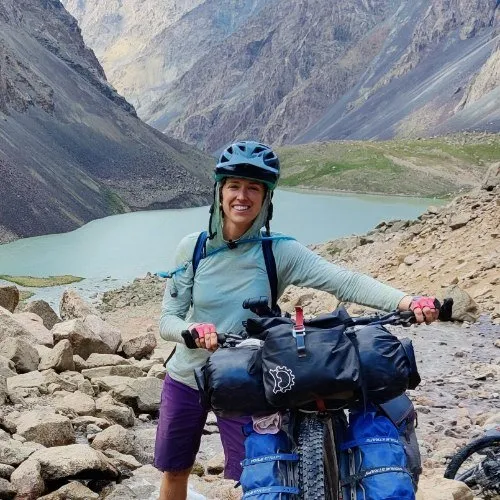
About the Author
Hi there, I’m Alissa, founder of Exploring Wild. I’ve traveled over 19,000 miles by bike and still can’t stop planning my next ride (and helping you plan yours). Pavement and panniers or singletrack and seat bag, I love it all. On my bike I feel free. Learn more about me here .
Shop Bikepacking Resources

Bikepacker’s Companion eBook

Bikepacker’s Fix It Kit

Bikepacking Trip Planner Workbook + Templates
Excited to try bikepacking but need help getting started? The Bikepacking Trip Planner Workbook can help you take the next step.

Bike resources in your inbox?
There’s more where this came from! Sign up here for occasional emails full of inspiration and information about bikepacking and bicycle touring .

Town Day Checklist!
Sign up to receive the free downloadable bikepacking town day checklist to help with your resupply stops:
You’ll also receive occasional emails with other bikepacking and touring resources. I think you’ll like them, but you can unsubscribe at any time.
Share the Adventure
If you found this article helpful, please consider sharing so more people can benefit from it:
Pin For Later

- Pinterest 44
4 thoughts on “New Mexico: Bikepacking The Great Divide #1 – Notes, Pics, & Tips”
Hello! Is it possible to do NOBO in new mexico during mid december-mid january?
Unfortunately not, at least nothing north of the very southernmost desert section. The mountains in central and northern NM get snow during the winter.
Hi Alissa, like many have commented before in your GDBMR nobo series of articles, your attention to detail, photos, tidbits and writing are a phenomenal source of information – thank you!
I am planning my trip and was wondering as a frame of reference, although I understand paces vary significantly based on numerous factors, do you know how many days it took from when you started (6/22) to get to get to the Colorado border, and as well as to Breckenridge?
Hi Veronica, thanks for the kind words!
Looking back at my ride log, I rode for 15 days (including one zero day in Grants) before my first night in Colorado. I was “getting in shape on the road” and not super fast in the beginning. I took a couple paved alternates due to rain, which might have saved a day.
From Stunner Campground (my first night in Colorado) to Silverthorne (just north of Breckenridge) was 7 days for me, including a zero day in Del Norte.
Leave a Comment Cancel reply
New in bikepacking & touring.

Charging Electronics While Bikepacking: Power Banks, Battery-Saving Tips, Solar and Dynamo

Review: S/F Expandable Hip Pack is A Handy Bikepacking-Friendly Transformer

Pitching a Tent in the Wind: Sanity-Saving Tips for Backpackers and Bikepackers

Brutally Honest Side-by-Side Comparison of Popular Solo Bikepacking Tents
Bikepacker's companion ebook.
Your experienced riding buddy in digital form: 140 mobile-friendly pages packed with how to's, problem solving tips, and hard-earned wisdom from the trail and road.
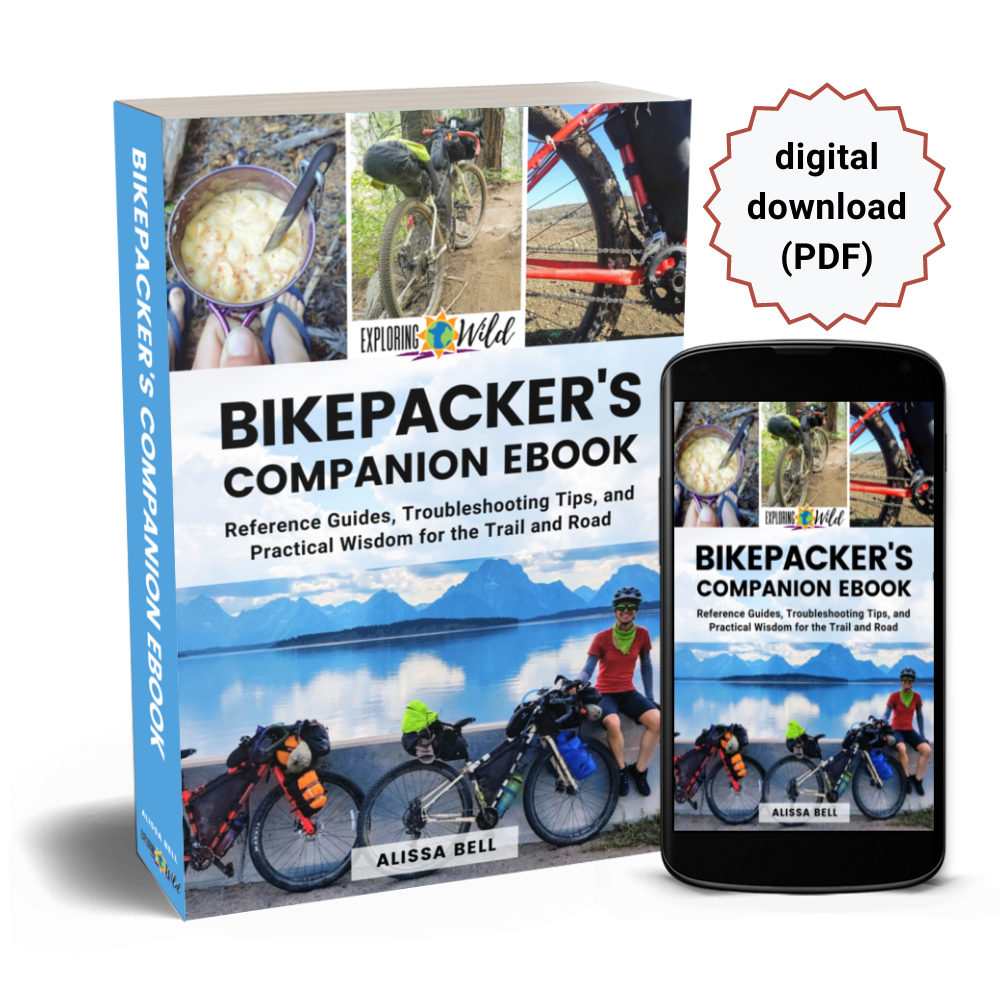
Bikepacking & Touring Rides and Routes Tips and Skills Bikes and Parts Gear and Reviews
Hiking & Backpacking Trails and Trips Gear and Clothing Tips and Advice Trip Planning Workbook
Adventure Travel Explore by Region Camping and Outdoors Mindful Travel
Donate to Tip Jar
About Exploring Wild
Web Stories
Adventure in Your Inbox?
Resources and inspiration to support your wildest dreams:
Affiliate Disclosure: This site participates in affiliate programs, including Amazon Associates. Sometimes my posts contain affiliate links, and if you make a purchase through these links, I may earn a small commission at no additional cost to you. I only recommend and link to products I know and love. Thanks for reading!
Trust & Transparency Policy
About | Contact | Privacy Policy
Copyright 2024 Exploring Wild, All Rights Reserved
Exclusive Member of Mediavine Home
Privacy Overview
Ultimate ‘Tour Divide’ MTB: Bike-Packing Build For 2,745 Miles
Share this:.
- Click to share on Facebook (Opens in new window)
- Click to email a link to a friend (Opens in new window)

[leadin]The Tour Divide is a 2,745-mile bike race from Banff, Canada, through the Rocky Mountains of the U.S., to the border of Mexico. For riders like David Markman, building up a custom mountain bike is an obsession and requisite task to increase odds of completing the rugged route.[/leadin]

Six lithe frame bags, food pouches, a swooping and esoteric handlebar setup, a GPS unit, and multiple high-power lights: The bike David Markman built for the Tour Divide is one unique rig. And did we mention the USB port on the stem?
To live off your bike and ride 150 to 200 miles a day for weeks in a row requires physical stamina and dialed gear. Markman, 27, of Avon, Minn., took years perfecting a system. He spends weekends training, and his day job at Quality Bicycle Products lets him obsess over every detail of his bike, gear, and race plan.

“I can plug my phone and GPS to charge right here,” Markman said, pointing at the USB port embedded on the stem. Wires lead down the fork, snaking to the front-wheel hub. A power-generating unit milks electricity off the rolling wheel, enough power built up each day to charge gadgets and run his lights.
Ultimate Tour Divide Bike
Markman embarks in mid June on the Tour Divide , an approximately 2,745-mile bicycle tour from Banff to Antelope Wells, New Mexico, along the continental divide through the Rocky Mountains.
It is unsupported, so riders can do it when they choose, and times are compared to determine the year’s fastest rider. (The men’s course record, according to the Tour Divide Facebook Page , is 14 days, 11 hours, and 40 minutes by Josh Kato; the women’s record is 15 days, 11 hours, set by Lael Wilcox, TWICE, in 2015.)
That also means that every detail — food, sleep, repairs, communication, navigation — must be accounted for in the small volume that can be carried aboard the bicycle.

Riding between 150 and 200 miles a day (he hopes to finish within 18 days) on a 46-pound (full-packed) touring bicycle on a route with around 200,000 feet of vertical, stopping only to sleep, makes Markman a veritable furnace.
“On a rest day, I probably already eat between seven and nine thousand calories, just sitting around,” he said. “On a workout day, it’s hard to quantify because I’m eating constantly.”
His bike, a Salsa Fargo model, was put together piece by piece. Markman owns a bike-bag company on the side called Must Stache , and his custom zippered frame bags hold the majority of his gear.

A full gear list is below. Tour Divide racers lean on ultra-light gear for sleeping and warmth. Bike-repair products are essential on the long ride. Food and water, which are picked up ad hoc and planned along the way, make up additional weight.
Here is his comprehensive list:

Bike: 2015 Salsa Fargo
- Whiskey carbon fork
- Enve seat post
- Specialized Power saddle 168
- Salsa Woodchipper Bars (extended two inches)
- Profile Designs aero bars
- Enve M60 carbon wheels (front: SP dyno hub; rear: Hope Pro 4 hub)
- Electricity-genrating hub
- USB port (on stem; for recharging phone, GPS)
- Vittoria Mezcal G+ tires, set up tubeless
- Supernova E3 Triple dyno lights x2 (1600 lumens)
- Exposure Diablo MK7 helmet light (1300 lumens)

Sleep System
- Nemo Siren 30 Quilt
- Black Diamond Twighlight Bivy
- Thermarest Pro Lite sleeping pad
- Big Agnes down jacket
- Lightweight hat
Rain And Cold Riding
- Patagonia R7 rain jacket and pants
- Podiumwear wind vest
- Giro long-finger gloves
- Louis Garneau knee and arm warmers
- Swiftwick tall and short socks
Accessories
- 2 Schwalbe EVO tubes
- Power cables for helmet light, phone and GPS
- Park Tool hand pump
- Tour Divide maps
- First-aid kit
- Spare headlamp
- Extra brake and derailleur cables
- Tire levers
- Mini pliers

- Baby wipes (“to stay fresh”)
- Toilet paper
- Chamois butter

- Shutter Precision PD-8X dynamo hub generator (see photo above). This generator is attached to (and charged by) his front wheel hub. It runs to a switch system Markman designed, and can charge a USB and power his E3s light.

- Six total: a seat bag, frame bag, two top tube bag, and two feed bags (one for food, one for trash). All six are from Markman’s own company, Must Stache Bike Bags .
- Pearl Izumi X-Project 1.0
- Garmin ETREX 30X
- One 20-ounce bottle
- One 24-ounce bottle
- One 100-ounce MSR Drome
- No filtration system or purification tabs

Follow Us On
Subscribe Now
Get adventure news and gear reviews in your inbox!
Join Our GearJunkie Newsletter
Gear Top Stories Deals

Your cart is currently empty!
Touring the Great Divide Mountain Bike Route vs. Racing the Tour Divide
Riding the Great Divide Mountain Bike Route (GDMBR) or racing the Tour Divide is a rite of passage for many bikepackers; it’s seen as the “Big One” in North America. Stretching 2,745 miles from Banff, Alberta to Antelope Wells, New Mexico, it loosely follows the Continental Divide through the Rocky Mountains on a series of dirt and paved roads. The fastest men can complete the route in under 14 days, while most people who tour it take six to ten weeks.
In 2018, I had the opportunity to tour the Great Divide Mountain Bike Route (GDMBR) with my husband Andrew Strempke. While we initially were attracted to racing, the rules of the event require solo, self-supported travel, and we wanted to ride together. And so we did, completing the route in 25 days. Four years later, in 2022, we both lined up to race the Tour Divide with the intention of completing the route within the constraints provided by the event. While we weren’t going to go out of our way to avoid seeing each other out on the route, the reality was that unless something went very wrong for Andrew, the chances of us riding near each other was fairly minimal.
Touring versus racing the route yielded two vastly different experiences. Racing tends to be more glorified by other people, but touring was just as satisfying, and in 2018, I believe it was the better choice for me at the time. There are benefits and drawbacks to each style of trip, and I feel lucky to have been able to experience both.
Rules, What Rules?
While the Great Divide Mountain Bike Route is open for anyone to ride under any style, signing up for Tour Divide means that you’re agreeing to pedal your bike from Banff to Antelope Wells in a self-supported solo fashion following the route mile for mile. On the other hand, touring provides the freedom to accept assistance from anyone, to share gear with as many people as you want, ride as fast or slow as you desire, and to detour around impassable roads or sections of the route that you’d rather not ride.
Touring: There are no rules! Choose your own adventure! The biggest determining factor that caused Andrew and I to choose touring over racing in 2018 was the Tour Divide’s rules about riding solo and self supported. Completing the route together was more important to use than officially completing Tour Divide. Andrew and I rode side by side the whole time, supported each other during low points, and kept each other entertained. We split gear to lighten our loads and deviated from the route a couple of times when following the route would have meant pushing through hours of mud, something we preferred to avoid whenever possible. We did want to complete our tour under our own power, so we didn’t ever get into a vehicle with the exception of a short road section that was under construction. The workers required us to take the pilot car until the end of the one-lane section of road. There was no one to question whether taking that ride in the pilot car invalidated our ride.
Racing: When I signed up for the Tour Divide, I agreed to abide by the rules of the race. There aren’t many, but the gist is that you agree to follow the entirety of the route in a solo self-supported fashion. With so much rain this year, making a turn onto a road I knew would be a sloppy mess when there was a perfectly good paved road that parallels the route was a bummer at times. That being said, knowing I was following the same route as all the racers, facing and overcoming similar challenges, and finding ways to make it through challenging conditions was rewarding in the end.
Riding self-supported also means carrying your own gear. When my dynamo light broke and I knew I’d have to spend more time charging electronics in towns, another racer offered me his extra battery pack and a light. While racer-to-racer support is typically tolerated, this definitely felt like a gray area and seemed a lot like sharing gear, so I chose to decline the offer, even though it would have saved me time.
Following the rules challenged me to solve my own problems and be mentally flexible when unexpected issues arose, which helped me to grow in my confidence as a bikepacker and solo woman traveler.
Counting Grams, Optimizing for Safety
The main difference in my gear between racing and touring was due to the fact that I couldn’t split the load with anyone during the race. Since I was going solo, it was important to maintain all of my own gear. I also had to be confident in using everything I carried. I wouldn’t have Andrew’s light or utensil or jacket if something happened to mine.
Touring: As we prepared for our tour, we decided we wanted to go light. We went with a minimal setup with no stove, no extra camp clothes, and one set of riding clothes. We split tools, a first-aid kit, and a two-person tent. Since we were on a 30-day timeline for our trip, including travel to and from the start, we had to cover ground quickly, and minimizing the weight on our bikes made a significant difference in the speed we could travel. The fact that we were able to share gear meant my load was actually lighter on the tour than it was racing.
Racing: When choosing gear for a race effort, it’s always a balance of being as light as possible while still being as safe as possible. I made some gear changes based on what I learned from the tour and my additional bikepacking experience. On the 2018 tour, I brought a 30-degree quilt and a foam pad and found myself too cold a few nights. For the race, I upgraded to a 25-degree sleeping bag and an insulated air pad. This setup actually ended up being too warm for most of the race and I woke up several nights in a puddle of sweat and drool, but it gave me confidence that I would be warm despite the wet and cold weather. I also brought more substantial rain gear after getting rained on during our tour in 2018 and finding that ultralight rain gear just doesn’t keep me warm or dry enough. I also chose to use a synthetic puffy rather than a down puffy. Synthetic insulation stays warm when it’s wet and down does not, but it also doesn’t compress nearly as effectively. I anticipated being soggy from rain or sweat for at least part of the ride, so the trade-off was worth it. I made sure all my tools worked and that I knew how to use them to fix common mechanicals.
Optimized for Speed…or Enjoyment
When people hear “touring,” they tend to automatically think you’re going slow and bringing the kitchen sink. That wasn’t the style of tour we were interested in, though plenty of people do that too. During our tour, we rode fast, but took it slow in towns to eat lots of food and get plenty of rest. In the end, my race pace was several days faster, not necessarily because I actually rode faster, but mostly because I just rode longer and stopped for as little time as possible, rushing through resupplies and meals.
Touring: Andrew and I completed our tour in 25 days, which is a pretty quick pace for a non-race effort. It felt good to challenge my body to go hard and cover ground quickly. I loved riding my bike all day and anyhow, we were on a timeline. Despite having a deadline to be back, not having the pressure of racing allowed us to slow down without guilt. One of our favorite stops during the trip was the Llama Ranch in Montana. We arrived in the afternoon and spent the rest of the day visiting with the owners Barbara and John rather than pushing on until dark. Later in the route, we stopped at Brush Mountain Lodge for several hours in the middle of the day where we ate pizza and drank beer, sitting and chatting for a few hours before continuing along the route. Being able to stop and spend time with Kirsten, who runs Brush Mountain Lodge was special, and she has become one of our best friends since then. Even though our tour took longer than the race for me, it was certainly not easy. No matter the pace, the Divide route will kick your ass some days.
Racing: My finish time during the race was 19 days and 16 hours. I probably didn’t actually ride much faster, but I rode longer each day and minimized stop time to complete the route in less time. Optimizing stop time and systems is one of my favorite parts of racing. It feels like free speed when you can get in and out of town or set up and tear down camp efficiently. I’ve tried to figure out exactly why I like bikepack racing and I honestly don’t have a great answer. I love challenging my body and the camaraderie of the other racers. I like making decisions under pressure and being forced to rely on myself to solve problems. Crossing a finish line knowing that I used my body and brain to the best of my ability to traverse an established route as fast as I could is a rewarding feeling.
Following The Route…Or Not
The Tour Divide route and the Great Divide Mountain Bike Route have some minor differences. When we were touring, we followed whichever one made sense at the time and deviated a few times when it made sense. When I chose to race, following the Tour Divide route mile for mile was required.
Touring: Making route choices was something extra we had to think about on our tour. We had the freedom to choose where we’d ride, but we also had to take responsibility for those choices if things didn’t work out. Our first detour from the Tour Divide route was around the hours-long hike-a-bike up Koko Claims in British Columbia, Canada. We had done zero hike-a-bike training and figured the risk of injury using untrained muscles wasn’t worth it. We talked to a local mechanic in Banff and he confirmed that going through Sparwood was a better choice for us and even gave us recommendations to take some new singletrack that paralleled the Great Divide Route. We had a blast on that section of trail and when we rejoined the route in Fernie, we saw racers with mud-covered bikes and bodies. Andrew and I looked at each other and agreed that we made the right call.
We didn’t escape every opportunity to hike through mud, though. Our longest mud stretch was on the legendary Bannack Road. We hiked for miles with our bikes on our shoulders or backs when rolling our bikes meant the tires collected mud and became bogged down in seconds. After encountering another rider at an intersection who told us the next section “was like something out of a nightmare” with more mud, it was an easy decision to take a paved short-cut into Lima. We agreed that detouring around long hike-a-bike sections with mud would help us maintain our sanity and have more fun on our trip. Detouring around spots that promised only suffering and misery didn’t make me feel any less like a route finisher at the end, but it definitely made for a more fun experience. I felt successful just getting from Banff to Antelope Wells under my own power.
Racing: To be a Tour Divide finisher, I was required to follow the published race route exactly. The times I went off route for supplies, I had to re-enter the route at the same point I left it. A wrong turn meant I would need to go back from where I deviated from the route to correct the mistake. When it was raining going over Togwotee Pass, I had to make the turn onto the notoriously muddy Brooks Lake Road to hike and ride through slop and snow instead of detouring on the paved road that paralleled it. When I’d toured the route, I’d taken the detour, so I knew exactly how nice the pavement was while I was trudging along at a mile an hour.
Participating in the race made route decisions easy. I just followed the line on my GPS and hiked when I needed to. If I wanted to finish, I had to stay on route. Since detouring around slow or potentially dangerous situations wasn’t an option, I also had to consider weather forecasts and my timing carefully.
During the tour, we didn’t really care how long resupply stops took. We typically sat down for a meal in a restaurant at least once a day and drank local beers. While I was racing, efficient resupplies were important. Limiting stop time is free speed and since I was demanding so much of my body, I didn’t drink beer along the way.
Touring: On our tour, we ate well and neither of us lost weight. Missing restaurant or grocery store hours didn’t mean we needed to keep moving to the next stop or eat a gas station burrito for dinner, we could just… wait. The pace of our resupplies was relaxed. We often took two-hour lunch breaks at restaurants and leisurely walked down the aisles of a grocery store or gas station until we had everything we needed. Salida became one of my favorite towns on the route after eating a huge barbecue Hawaiian pizza and salad at Moonlight Pizza and Brewpub. We slept in a hostel there and stayed up late talking with Continental Divide Trail hikers and other travelers. Our huge meals at cafes and conversations with both locals and other bike tourers added to our experience and gave us a flavor of the communities we were passing through.
Racing: Logistics and efficiency can be an interesting puzzle to figure out during a bikepacking race. Riding later into the night meant that hitting towns during business hours was more challenging. Before the race, I studied the towns and added business hours to a spreadsheet. I was aware of the times I might need to stock up on more food if I was going to potentially miss the next resupply.
When I was a few miles from a town, I would pull up my spreadsheet where I had calculated the distance, estimated time, and estimated calories needed to get to the next stop. I would start making a list in my head of the foods I wanted to get. “Potato chips, candy bars, some kind of gummy candy, pastries, burritos.” You know, all kinds of healthy stuff. I would run over that list in my head, picturing where I might find those things in the gas station or grocery store I was headed to. When I arrived at the stop, I would immediately start looking for an outlet if I needed to charge my electronics, then I would go into the store with my phone calculator in hand. I would walk down the aisles putting food into my basket, adding up the calories until I had enough. Then I would focus on the meal I wanted to eat right then. Normally a vegetarian, I made some exceptions to my normal diet, eating chicken at times when I couldn’t find another good protein source in a gas station.
I ate while I packed up my bike instead of sitting down at a restaurant with one exception. I arrived in Sargents, Colorado, feeling nostalgic. It’s where the Western Express ACA Route crosses the Great Divide Mountain Bike Route. Having been there with Andrew both on our cross-country tour in 2012 and our 2018 tour got me all sappy and I felt like I needed to sit down, reset, and get some real food in me.
Companionship or Solitude
I feel lucky to have shared the Great Divide Mountain Bike Route with Andrew. We made countless memories that we still reflect on today. During the race, I found companionship, but my time with other racers was brief and I spent most of the ride by myself. This might sound lonely, but I also really value alone time and moments spent by myself in beautiful places can be equally as moving for me as moments in those places with another person.
Touring: Andrew and I rode the entire route side by side. It was really special to have shared the experience with the most important person in my life. We were in tune with each other’s needs, moods, and when to provide a gentle reminder that maybe the other needs a snack. When conditions were tough, we kept each other’s minds busy by playing 20 questions. We made decisions as a team about where to stop for food and where to camp for the night. We had both of our brains to deal with mechanicals and make decisions about any reroutes.
In general, riding together tends to be slower. You’re going whatever pace the slowest person at the time is going and end up taking more breaks since you’re dealing with two people’s needs. We typically rode about the same pace and if one of us needed a break, the other was patient. We both wanted the other to feel good and enjoy the ride.
Andrew and I are fortunate that we get along really well, but we did have our moments. I know that Andrew was pretty upset with me when I lost my rain jacket on a rough descent one day just before sunset. (I have since learned that everything that I want to keep goes in a zipper pocket). He sprinted back up the road to go find it while I rode much more slowly behind him. Fortunately a kind racer picked it up so he didn’t have to ride too far up the climb. Then there was the time when Andrew insisted on taking photos of the Montana/Idaho border sign in a thunderstorm. As someone who hates thunderstorms, all I wanted to do was ride down the pass and became increasingly frustrated as Andrew insisted on taking several selfies.
Racing:
While the Tour Divide is set up to be ridden solo, many racers end up forming small groups to ride with. While I rode mostly alone, I did have some time riding alongside other racers, typically for a short time. I would see other racers in towns and when we took breaks. Spending time with people briefly once a day was enough social interaction to keep me sane. I’m a pretty introverted and independent person. Extensive alone time doesn’t bother me and is something I look forward to. Still, every time I would run into my good friend and fellow racer Zack, who was also on a singlespeed, we would chat and share a few miles. The emotional boost provided by those interactions was undeniable.
Andrew was also racing the Tour Divide this year. We anticipated not seeing each other unless something went wrong for him. We agreed not to communicate about the race at all while we were out there. We sent a few voice memos with funny stories. I told him about the time I ate jalapeño chips and they went down the wrong pipe and I gave myself a bloody nose coughing them back up. We promised to not say, “I miss you,” because it just makes us both sad. But I did miss him, and being alone definitely reminded me how much I love Andrew, my friends, and my family.
One of the hardest moments during my race was leaving Brush Mountain Lodge. Kirsten wasn’t planning to be there during the race, but she was. I had already stopped in Savery just 15 miles down the hill for an hour, so I didn’t have more time to spare to spend time with her and my good friend, Jolly, who was helping at the lodge. I left in tears, wishing I could have stayed. I was comforted by the thought that I could come back to the lodge after I was finished.
Traveling solo meant that I generally had to deal with my fears alone, but after a particularly scary lightning experience outside of Pie Town, I was glad to be able to decompress with other bikepackers and hikers at the Toaster House in Pie Town. Just a few miles out of town, I’d felt electricity running through both of my hands through my handlebars and jumped off my bike and got under a small clump of juniper trees. I set up my tarp to stay dry and sat in the lightning position until the storm passed. I was pretty hysterical. After that, I decided to stay at the Toaster House in Pie Town. I felt like I needed indoor accommodations and to talk to other humans to feel okay to go back out into the elements the next day. Jefferson, the host, made a hot meal for me, the other bike tourers, and the CDT hiker staying there. I spent a lot more time talking with them than I normally would have during a race. Talking about our experiences on the route and what life is like outside of bike touring and racing helped me to reset and calm down.
Outside of the emotional support of companionship, I had to be confident in my ability to fix my bike, make good choices in a fatigued state, and be safe on my own. I haven’t always felt confident bikepacking solo, but as I’ve gained more experience I’ve become more comfortable. One of the only times I felt weird being alone is when I saw a man on the side of the trail who was loading a gun. He asked, “Are you alone?” I went ahead and told him that there are other riders right behind me, which is my typical answer for any man who asks me that question.
Sharing the Experience
I wanted to document both our tour and my race. It’s so easy to forget little details if you don’t record or write them down. Documentation takes extra effort, but I’m happy that I did it during both trips.
Touring: On our tour, I laid in my sleeping bag and typed out a blog post with pictures from my phone every night so that our friends and family could follow along, and now I can look back and remember something from each day of the tour. Andrew also took an action camera and made a video about our trip. I found that we were less likely to record our low moments riding together since it’s a bit rude to put a camera in your partner’s face when they’re having a bad time.
Racing: Documenting my race was important to me. I carried a GoPro and posted occasional Instagram stories. Race documentation by outside media crews during the Tour Divide has been met with controversy in recent years, so aside from wanting the footage for myself, I wanted to show that there is a self-supported way to tell my story. My Instagram stories and GoPro footage is certainly not as beautiful as a professionally documented film, but it’s raw and I like it that way. Most of my documentation was done while I was pedaling, and I put together the GoPro footage when I was recovering after the race.
It’s interesting to think about the ethics of posting on social media in the context of self-supported racing. I inevitably got encouraging messages whenever I posted. Knowing that my friends were watching definitely made me want to continue to ride my best. Ultimately I decided that since people generally have access to a smart phone with social media, I wasn’t giving myself an unfair advantage by posting on Instagram. Some may disagree, but I feel good about what I chose to do during the race. I was intentional about my posts as to not solicit advice or support from other people and maintain the self-supported nature of the ride.
Romance, or Lack Thereof, of Camping
For a lot of bikepacking trips, finding a beautiful camping spot can be a highlight of the trip. When racing, I went to bed after dark and any spot was as good as the next. We put a little more intention into camp spots while touring, and I slept better during our tour knowing there was another set of ears next to me.
Touring: Andrew and I slept most nights in our two-person tent. We’d start looking for a spot to camp as sunset approached. We didn’t care so much about whether we slept somewhere scenic, but we had higher standards than when I raced. We got a couple hotel rooms when the weather was wet. I admittedly stole Andrew’s puffy jacket on nights when I was cold! We typically woke up with the sun and quit pedaling at sunset, giving us plenty of rest. We rode past dark one night in New Mexico to beat the heat which turned out to be the only time we saw a bear during the entire trip. Aside from those few miles, we saw the whole route in the daylight.
Racing: My standards for camping while racing were pretty low and I almost always rode past sunset. I didn’t mind riding in the dark since I had seen the route in the daylight before. Riding at night is a new way to experience the same place differently. I love looking up at the stars on a clear night and seeing animals who are normally sleeping during the daytime. Since I was riding more in the morning and evening, I had way more wildlife sightings during the race than during the tour. I saw several bears, one little fuzzball of a bear cub, a mountain lion, three moose during the day and three at night, countless deer and pronghorn, and a handful of other smaller animals.
When it was time to choose a spot to sleep, I made sure the location I chose was dry and not too high in elevation. If there was snow, that was a hard no. In New Mexico, the monsoons were so intense that it was difficult to find a spot that didn’t look like water was running there at some point. The worst camp spot I chose was on the side of the highway under a tree next to a bunch of garbage. It was one of the only dry-ish spots I could find.
I enjoyed indoor accommodations twice during the race, at the Llama Ranch in Montana and at the Toaster House in New Mexico. Those nights felt very luxurious. If you count pit toilets, I had a few additional nights inside in bear country. I camped with other riders for two of the nights. Aside from that, I slept under my tarp, in my bivy, by myself.
Getting to Antelope Wells
During both trips, a big goal was finishing the route. I made different decisions during both trips to meet my goals. While I was racing I had to make these decisions under pressure.
Touring: The top goal for our tour was finishing the route. While we were on a timeline, we took a couple of shorter days in the beginning while our bodies got used to pedaling long miles. It wasn’t a big deal to stop early because there was no pressure of racing. When Andrew’s Achilles tendons started to flare up a few days in and we saw a sign for a brewery in the middle of nowhere, we stopped and drank beer even though we had just taken a lunch break. This gave his ankles a much needed rest, allowed us to reflect on all the riding we’d done so far, and gave us a Montana cultural experience. Being able to make choices without the pressure of racing undoubtedly helped us make decisions that got us to Antelope Wells.
Racing: Finishing the route was also a goal for the race, but more than that, I wanted to go faster than I did during our tour. If for some reason I wasn’t able to go that pace due to body or bike issues, I probably would have considered scratching. It just wouldn’t be worth putting my body through the stress if I couldn’t meet my goal. This was definitely a change in attitude for someone who used to value finishing at all costs.
During the race, I let the speed of others dictate some of my decision making. The day I got into Colorado, I was the third woman. I was six hours behind Ana, the second woman, and 14 hours behind Zoe, the first woman. It was clear to me that I had no chance of winning without making a huge move. I thought to myself, “All I have to lose is my sleep and sanity.” That night I rode much later than I had on previous nights, slept for two hours, and got really close to Ana. But the decision to sleep so little meant I was worthless the next day. All the people riding the same pace as me before caught back up to me by the end of the day. The pressure of racing guided me toward sacrificing sleep when I should have taken better care of my body. When I found out Zoe quit that day I felt pretty dumb for letting her distance ahead of me dictate how much I slept. I re-learned the lesson that I need to take care of myself to ride strong and making decisions based on how another person is riding is usually a mistake. Had I kept riding and sleeping the way I should have, maybe I could have stayed closer to Ana in the end.
Feeling Part of Something
Humans, even the introverted ones, are all social creatures, and our brains are wired to want to be part of a community. During both trips, I felt part of a group of bikepackers riding their bikes from Banff to Antelope Wells. When we were touring, we definitely felt different than the racing group.
Touring: While we started our tour on the same day as the Grand Depart of the Tour Divide and were around racers much of the time, it felt like we were doing something different than they were. It wasn’t a positive or negative thing, just different. After finishing, I definitely felt part of a group of people who have completed the Great Divide Mountain Bike Route, and when we meet people who have accomplished this feat, we have an instant connection.
Andrew and I were fortunate to be able to help out at Brush Mountain Lodge in 2021. During that time, we talked with racers and hundreds of people touring the route. Often the tourers would say, “I’m just touring.” When I heard that, I tried to tell them that you don’t have to say “just.” I totally get it though. Andrew and I said the same thing when we were touring and people in towns asked us if we were racing. Sometimes they would treat us differently than racers. There were places with banners for only racers to sign or some people would become uninterested after they found out we were “just” touring. That wasn’t the case everywhere. Kathy from Ovando greets every bikepacker who comes through town with the same enthusiasm regardless of racing or touring status.
Racing: When I sign up for a Grand Depart event, I feel a connection to the racers around me. It helps when I’m walking through snow, riding through rain, or staying up late into the night knowing there are other people out there doing the same. I have always experienced this as a positive thing until this year. There were 15 rescues in the Canadian Flathead in the first few days of the race. There were reports of racers using hotel towels to clean their drivetrains. Later in Montana I ran into a local man trying to get home but couldn’t because photographers following the race blocked the road. When I heard about the rescues, poor manners at the hotel, and saw the behavior of the photographers, I was embarrassed to be part of the race. It made me angry that people participating in the Tour Divide were having a negative impact on the communities the route traverses. I’m hopeful that future Tour Dividers can look at this year as a learning experience and that future racers give more respect to the route, the power of Mother Nature, and the people along the route. That being said, for the majority of racers who completed the route, the challenging weather conditions this year provided an unforgettable experience and swapping stories with other racers will be something we can do for years to come.
As a woman racer, I also feel a strong connection to other women on the route. All of the racers I saw were men, though I saw several northbound touring women and always stopped to say hi and have a brief conversation, usually about the route ahead. While I didn’t see other women racers after the first day, when I got to Colorado, I did my best to chase down Ana. Ana managed to stay ahead and went on to win the women’s race, 15 hours ahead of me. Even though we never met, somehow I felt like I knew her since I traced her tracks on the trail. When I got to meet her later in the summer after she crushed the Colorado Trail Race with a second-place finish, I considered her a friend instantly.
Racing or Touring
I’m so grateful Andrew and I had the opportunity to tour the route together in 2018. We did have limited time, so it was a fast tour, but we never felt rushed and didn’t have to follow the rules of the race. We shared gear and deviated from the route when it made sense. Our resupply stops were relaxed and we ate lots of huge meals at cafes along the route. We stayed well rested and well fueled. When I thought I only had one opportunity to experience the wonder of the Great Divide Mountain Bike Route, I chose to ride it as a tour and I would 100% make that same choice again.
Racing offered a new experience of an incredible route. At the finish, I was totally depleted. I left it all out there mentally and physically. I was proud of my effort and the fact that I was able to race the route faster than I rode it before. Thinking about all of the tough times I had out there and how I was able to overcome the challenges of the weather, terrain, and my own fears made me feel confident and accomplished.
Sometimes there is more external motivation to participate in an event or race. People tend to glorify racing over touring or other creative endeavors even though each of these experiences has value. I definitely got more attention for finishing the Tour Divide as a race rather than a tour. Bikepacking.com published an article about how I was the second woman to finish the race and how I raced on a singlespeed. But, my close friends and family were just as excited when I finished my tour as when I finished the race, and those are the people who matter most.
At times touring an established route or making your own route can be more intrinsically rewarding than participating in a race. Before I choose whether to race or tour a route, I’ll consider what my body can handle, my personal goals, and my motivation. I plan to continue pursuing both racing and touring, collecting as many lessons and taking in as much beauty as I can along the way.
Your support means the world to us. If you enjoy our work, please consider making a donation to help us with our mission.
Katie Strempke
12 responses to “Touring the Great Divide Mountain Bike Route vs. Racing the Tour Divide”
Based on my dreams and ambitions, this is some of the best bike-related content I have ever had the pleasure of consuming. I would never dream of racing, but it was very interesting and useful to read about the different perspectives. If I ever had the chance to meet you, I would ask questions about mechanicals, laundry and hygiene.
Thanks for putting this together!
This is a really cool perspective. Thanks for sharing, Katie!
Thanks for taking the time to detail your thoughts of racing versus touring. I just finished my first bike packing race and connect to your words. Normally “just” touring, I gained a new understanding of the lure of Bikepack racing and how you don’t get back those extra hours stopping early or sitting down for a prepared meal. I did value so much meeting the other racers on route. I was especially excited to briefly chat with you as you filtered water and later on a paved climb about your gearing choices before you went on to crush it!!
Katie…Outstanding content, insights and inspiration! I did WY and CO sections of the GDBMR last summer (time of my life!) and I am ready for more…notably Canada and MT hopefully this summer. I want to do this ride with 1 to a few other riders. I’m a 61 year old slow and steady rider that enjoyed the company of a few Adventure Cycling companions during last summers ride. This year, my personal schedule does not allow me to sign up for one of their trips but that will NOT stop me from tackling the next 2 sections. Do you have any recommendations for finding a source to cast the net to see if there’s any interested riders I might connect with to explore joining my small band of slow and steady riders? I am planning loosely for about 50 +/ – miles a days mostly camping with definite stops at motels, hostels etc. to recharge and shower! While I love the camping aspect of bikepacking, I am ready to spend money as needed to be somewhat comfortable and recharge when necessary. My windows for travel this summer is 29 July to 19 August. I will cycle as much and as far as I can in that time.
Any advice would be much appreciated!
thanks for the inspiration!!
All the best, Tony Sirianni
The “Great Divide Mountain Bike Route – Trail Conditions, Q&A, Gear & Stories” Facebook group could be a good place to start!
Hi, do you have your gps track published? I’d love to know your route around koko claims!
Hi Mike! Here’s a post including the Strava ride for the route we took around Koko Claims.
https://dispersed.bike/blog/great-divide-day-2/
It’s been a few years, so might be worth checking with someone local. The GDMBR does not go over Koko Claims, so that’s an option too. We took a combination of the GDMBR route and followed recommendations from Dave, the bike mechanic in Banff to get off of the highway a bit more than the GDMBR route.
Katie, thanks for sharing your experiences on this route. What did Andrew ride (bike, drivetrain, gearing, storage accessories)? Thank you.
Hi Patrick! Here’s a link to Andrew’s gear lists for each of the Triple Crown races last year, including the Tour Divide. https://dispersed.bike/blog/triple-crown-gear-list/
Thank you for such an amazing write up. I’m an old duffer (55) thinking about attempting the route (race or tour) and this helped immensely
hi Katie! what’s the difference between riding the TD in singlespeed or with gear?what do you prefer?love to see the bike “clean” in a singlespeed but have to consider much more time to push the bike….. thanks Matteo ps: congratulations on your bike adventure!!
I didn’t spin much time pushing my bike, but I did spend a lot of time spun out! I’d say only ride singlespeed on the Divide if you already do most of your rides singlespeed and are passionate about riding that way.

Leave a Reply Cancel reply
Your email address will not be published. Required fields are marked *
Save my name, email, and website in this browser for the next time I comment.
Lachlan Morton sets scorching pace over Tour Divide route
EF Education-EasyPost says Australian rider finished with a time of 12 days, 12 hours and 21 minutes

On August 29 Lachlan Morton set out to take on the Tour Divide route – from Banff in Canada's Rocky Mountains to Antelope Wells in New Mexico – to see just how quickly he could do it even while including a self-imposed minimum of 12 hours rest every 48 hours. The answer, it turns out, is pretty darn quick. EF Education-EasyPost said that Morton had covered 2,670 miles in 12 days, 12 hours and 21 minutes. The acknowledged fastest known time set by a self-supported rider has long been 13 days 22 hours and 51 minutes, a mark set by ultra-endurance behemoth Mike Hall in 2016 over a course which has altered somewhat since. It was a longer distance according to Hall's tracking data of the time, which shows a distance of 2712.8 miles.
Still, Morton was fully aware when setting out that his time is unlikely to be considered a replacement self-supported record, as not only has the course of the annual self-supported race altered over time, the presence of a film crew has also been a contentious issue in the past given its impact on a key mental element in the self-supported race, being truly alone. Morton was confronted by a wide range of challenges throughout the 12-and-a-half days, with plenty of wet and cold weather, peanut butter mud, fire diversions , saddle sores, trench foot and a dead derailleur on day 11, which led to some bush mechanics.
Lachlan Morton chases Tour Divide record time but with self-imposed sleep quota Fires, wolves and dodgy coffee for start of Lachlan Morton’s Tour Divide Transcontinental: Racing 4,000km from Belgium to Greece in less than nine days
“I kicked it as hard as I could and then it started working again,” said Morton in an update from the trail, though then it stopped again. First option exhausted, Morton then resorted to shifting via a spoke shoved into the derailleur.
Morton's effort has also delivered more than just an impressive time, perhaps shedding just a little more light on a key, but complex, issue in ultra-endurance racing – whether it is possible to deliver a fast pace without sacrificing too much sleep.
"I am really interested to see with this approach, how fast you can really go and if it would be competitive with people who have really pushed that sleep element,” said Morton before setting out.
While not directly equating to sleep time, the data on Morton's tracking dot put his stopped time at 30 per cent of his total, which equates to a little over seven hours a day, and was higher than the percentage of stopped time shown in the tracking data of both Hall in 2016 – at around 24 per cent - and 2023 Tour Divide winner Ulrich Bartholmoes – at over 23 per cent.
Through the ride, Morton has raised funds for Adventure for All , with the total so far at over $20,000.
Get The Leadout Newsletter
The latest race content, interviews, features, reviews and expert buying guides, direct to your inbox!
12d 12h 21m. 2,670 miles (4,296 KM) ridden. 192,000 Feet (58,521 meters) climbed. Two countries visited. Five states and 1 province crossed. Four storms weathered. Unknown amounts of candy bars and gallons of milk consumed. pic.twitter.com/N91gHv0BVq September 11, 2023

Thank you for reading 5 articles in the past 30 days*
Join now for unlimited access
Enjoy your first month for just £1 / $1 / €1
*Read any 5 articles for free in each 30-day period, this automatically resets
After your trial you will be billed £4.99 $7.99 €5.99 per month, cancel anytime. Or sign up for one year for just £49 $79 €59

Try your first month for just £1 / $1 / €1
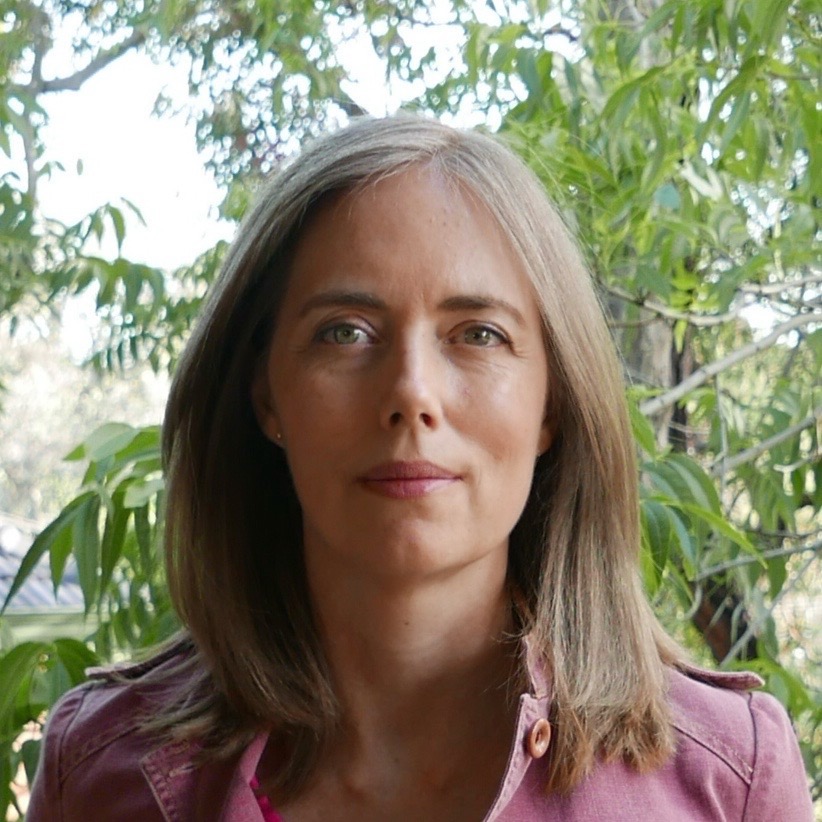
Simone is a degree-qualified journalist that has accumulated decades of wide-ranging experience while working across a variety of leading media organisations. She joined Cyclingnews as a Production Editor at the start of the 2021 season and has now moved into the role of Australia Editor. Previously she worked as a freelance writer, Australian Editor at Ella CyclingTips and as a correspondent for Reuters and Bloomberg . Cycling was initially purely a leisure pursuit for Simone, who started out as a business journalist, but in 2015 her career focus also shifted to the sport.
Decluttering mass starts, rewarding podium riders top changes to 2024 Life Time Grand Prix
Lack of communication and bad timing create nightmare for former NCL riders
Rooijakkers surprised with 6th place in Flèche Wallonne after attacking race
Most Popular
TOUR DIVIDE GUIDE - BIKEPACKING
YOUR ULTIMATE BIKEPACKING GUIDE TO THE TOUR DIVIDE.
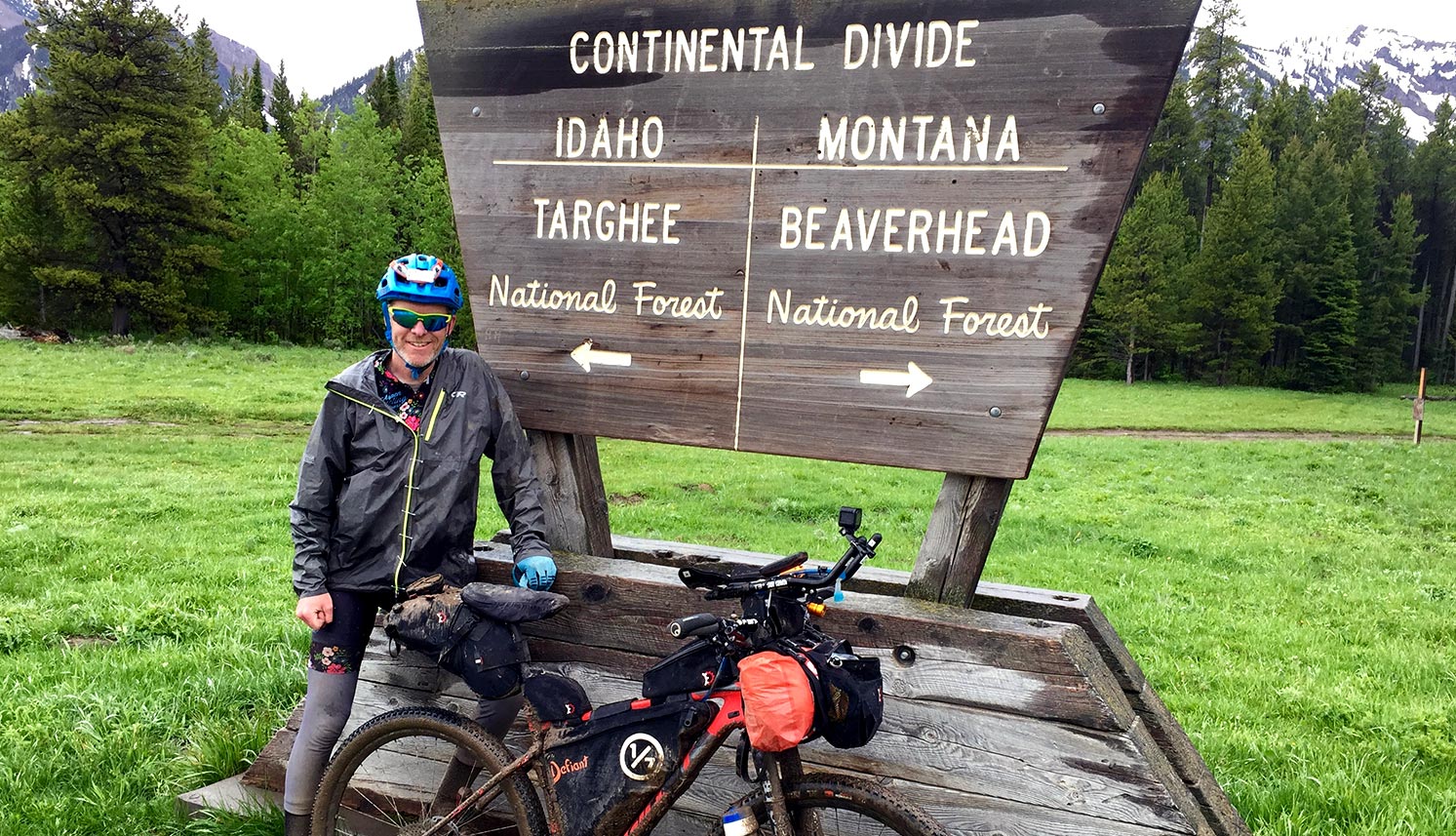
For more information on the Tour Divide visit our TD Resource page . »
Deciding to do the Tour Divide comes with a lot of questions and concerns. I can tell you they’re not as scary as they seem. If you start with a plan and break down the process your worries will change into confidence. Your biggest issue is finding the proper information.
This page is meant to be a simple overview of the Tour Divide. During my own Tour Divide I realized there was a need for a guide covering the route just for bikepackers. This page is broken down into simple sections so you can easily get a feel for the route. It’s also part of a larger all inclusive guide, so you can focus on riding your bike instead of searching the internet for hours on end.
Where do you start? This Tour Divide Guide is a great starting point but if you want to know more, checkout the “TD Resources” button below. You’ll find information on resupply, transportation, gear and more.
Do you find this page valuable?
Shopping with our affiliates helps fund the development of content like this.
Share this entry
- Share on Facebook
- Share on Twitter
- Share by Mail
Tour Divide Rider Survey
The Project conducts an ongoing rider survey to help new riders try to figure out what gear to use on the Tour Divide. Undertaking a ride/adventure like can be very intimidating and the planning can be overwhelming. It’s our hope this survey will help new riders with their planning and execution of their Tour Divide ride, as well as help ensure riders are more properly prepared for their adventure.
If you haven’t taken the Tour Divide Rider Survey yet and would like to you can at the links below.
***Please pay attention to the examples for the questions where you have to type in your answer. If answers are not entered EXACTLY like the example I have to go in and correct them and it also throws off the results. Thanks in advance!
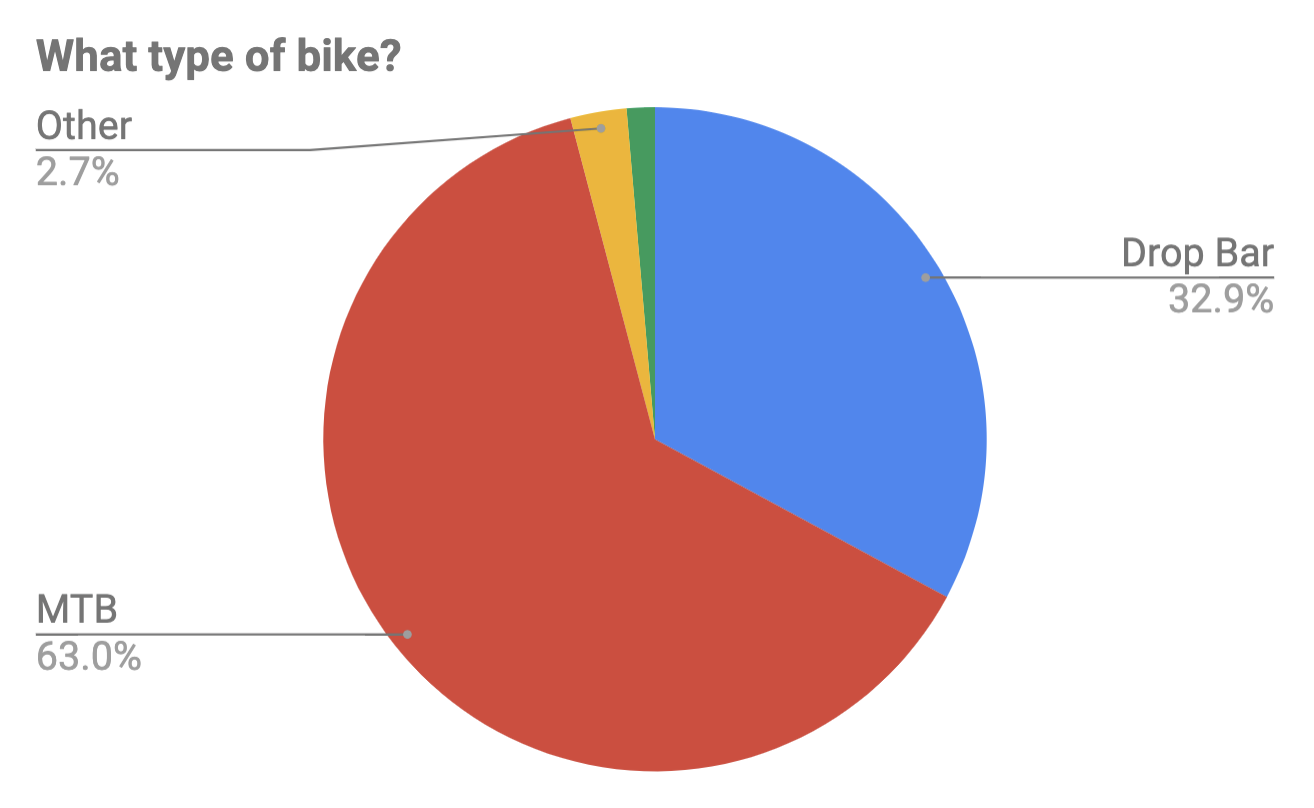
Covers: bikes, suspension, tires & wheels, drivetrain, and Components.
Covers: navigation planning, camping, logistic/travel, clothes, and more.
2745 Miles (4418km)
DIFFICULTY (1-10)
Elevation gain.
200,000 Feet (60,960m)
HIGHEST POINT
11,913 Feet (3631m)
TIME REQUIRED
% singletrack, time of year.
June to October
2nd Friday of June
Closest Towns to Start/Finish
Banff, AB and Lordsburg, NM
Race Record
Male Mike Hall (2016) 13:22:51 Female Lael Wilcox (2015) 15:10:59
The Tour Divide is an 2745 mile route that stretches from Banff, AB to Antelope Wells, NM. The route is roughly 70% off road, consisting of gravel roads, jeep track, and a very small percentage of single track. Traveling through the Canadian provinces of Alberta and British Columbia, and the states of Montana, Idaho, Wyoming, Colorado, and New Mexico, the trails covers a wide range of landscapes.
The route is based off the GDMBR* (Great Divide Mountain Bike Route) from the Adventure Cycling Association , and took four years to map and was released by in 1998. The first ITT of the route was in 2005, while the first Grand Depart was in 2008 (usually held on the second Friday in June). Only a handful of riders attended the first Grand Depart but today close to 200 brave men and women toe the line to test themselves against each other, the route, Mother Nature and most importantly, themselves.
Starting in Banff, AB the Tour Divide winds its way through the Canadian Rockies along glacial rivers and grizzly country. As it travels south the route samples many different types of landscape. In Montana and Colorado you’ll experience mountain wilderness, Idaho and Wyoming offer up grasslands and endless rolling hills, while New Mexico and southern Colorado have high desert. Near the border you are treated one last time with time spent in the Chihuahuan Desert.
Don’t let the fact that the route is mostly dirt roads and lacks technical single track fool you. The attrition rate is 60%. Exhaustion, hypothermia, boredom, and mechanicals are common place on this, the longest bikepacking route in the world.
*The Project doesn’t have a separate resource for the GDMBR but we do off planning aids. You can find them here .
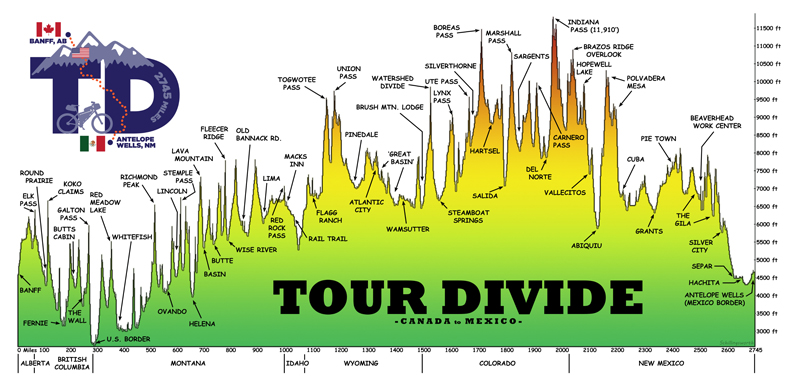
Elevation profiles provided by John Schilling. Support John’s effort by purchasing prints, sticks and mugs of these profiles.
2024 TOUR DIVIDE COUNT DOWN
June 14, 2024
TOUR DIVIDE RACING
TOUR DIVIDE
The Tour Divide is not an sanctioned or organized race in any way. Consequently it’s regarded as large group ride that follows a fixed route, a set time, a set of simple rules and that’s all. Those who partake should understand this and obey the gentleman’s agreement to “race” fairly and follow the rules. There are no checkpoints, race organizers, aid stations or aid of any kind. You’re solely responsible for your own welfare.
The TD starts in the Banff on the 2nd Friday of June. The start is now broken down in waves to help not over crowd the local trail system in Banff. There is usually a neutral roll out and the racing starts when you hit the dirt road just south of the Fairmont Banff Springs Hotel.
Suggested Start Date:
2nd Friday of June (staggered start)
Registration:
Send a letter of intent after winter solstice to [email protected].
Bikepack racing is generally not organized, no entry fees are collected or prizes given out, but there are a general set of guidelines all bikepacking races follow. As a result the rules are designed to create a level playing field for all who decide to participate.
*Note these rules are the general rules for bikepack racing and each event may have their own specific rules and they also change from time to time. With that said it’s important you read and understand the official rules which can be found at the link below.
1. Racers must completely cover the route under their own power.
2. No outside support is allowed.
3. Food/supply caching on the trail is not allowed ahead of time (but one can ship items to a Post Office).
4. Motorized transportation or hitch-hiking, EXCEPT for travel to hospital/medical care, is NOT allowed at anytime.
The following are allowed, but not encouraged. Please use sparingly.
5. Unintended assistance from fellow racers is ACCEPTABLE.
6. Trail magic is OK – but please, no begging or fishing (hinting).
7. Mailing resupplies to Post Offices is ACCEPTABLE.
For full rules visit TourDivide.org .
No entry fee, no prizes, absolutely no support
IMPORTANT RACE INFORMATION
Registration: Send letters of intent after the winter solstice to [email protected].
The GPX file can be found TopoFusion.com , and usually is updated about a week before the start.
In-Race Updates called “Rained Out” are used to update racers of any route changes/detours. Links will be emailed to you (via text message or email for non-US phones).
A Bear Spray discount (15%) is usually arranged in the months leading up to the start. Keep a watch on the Facebook pages for details.
Salsa stem caps are usually available at the start in Banff. You can get yourself a free piece of pie when you get to Pie Town, NM.
SPOT TRACKING
Racers and those touring the Tour Divide are encouraged to carry a Spot tracker, though they are not mandatory. Due to the remoteness and sheer difficulty of the trail I personal believe you’d be crazy not to. Racers can sign up at Trackleaders.com one month before the race if they choose to.
You can rent a Spot from Trackleaders.com around one month before the start of the race (You’ll receive information to your email you used when signing up). Check Trackleaders or Bikepacking.net forums for information at that time.
SUPPORT THE ACA
The Adventure Cycling Association (ACA) has no ties to the race but they did build the route, have created amazing maps and their a great resource . It’s because of them we have this amazing route to race/ride. Please consider joining the ACA. Membership is only $45 and as a member you get all kinds of discounts and other perks, most noteworthy a discount on maps.
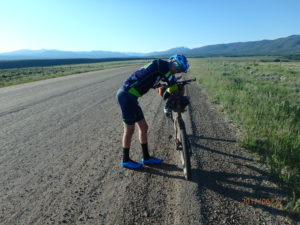
Tour Divide Planning Aids
Being that I’m also a Triple Crown thru-hiker I’m used to quality planning tools. After finishing the Bikepacking Triple Crown I realized bikepacking didn’t have quality planning tools available. The Project’s Planning Aids and Resources are our answer to this.
After 100’s of hours of research, 1000’s of keystrokes, more emails and phone calls than I can recall the One of Seven Project’s Tour Divide Planning Aids are done. They’re the ultimate planning resources for the Tour Divide. They contain everything you need to plan and execute your ride/ride of the Tour Divide and most of the GDMBR. If you can’t find what you’re looking for in these then it’s probably in our Tour Divide Resources .
Craig, I wanted to let you know that your bikepacking guides are incredibly well done and useful.
Small Bundles:
Big bundles:.
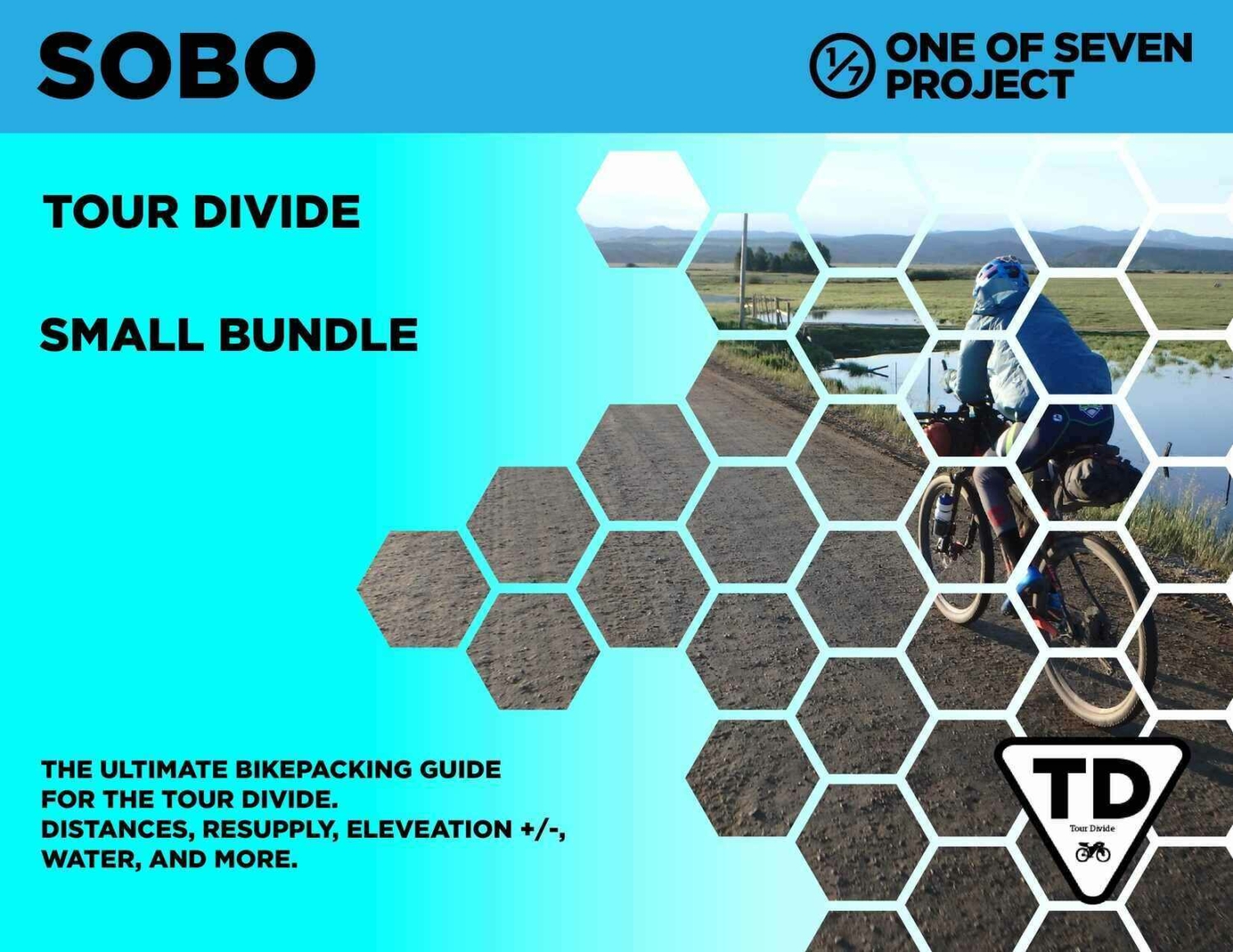
One package including our two most popular planning aids:
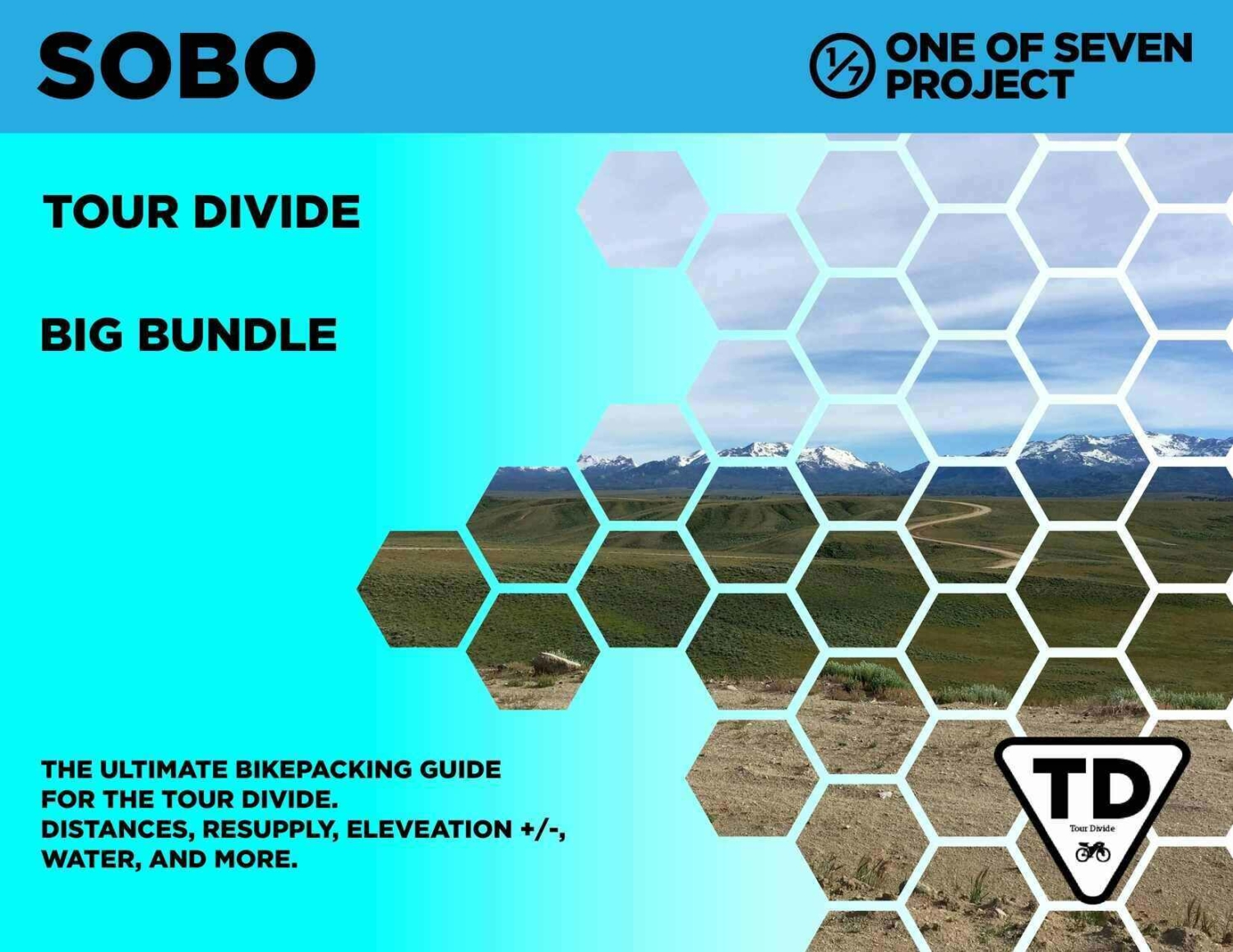
One package with all our planning aids:
- Mileage Chart
- Elevation Gain Chart
Available in both SOBO and NOBO versions and US Standard and Metric units.
Small Bundle – $40.00 + tax (CO only) *You save $10 when you bundle!
Big Bundle – $60.00 + tax (CO only) *You save $20 when you bundle!
Data Sheets and Town Lists
Data sheets:, town lists:.
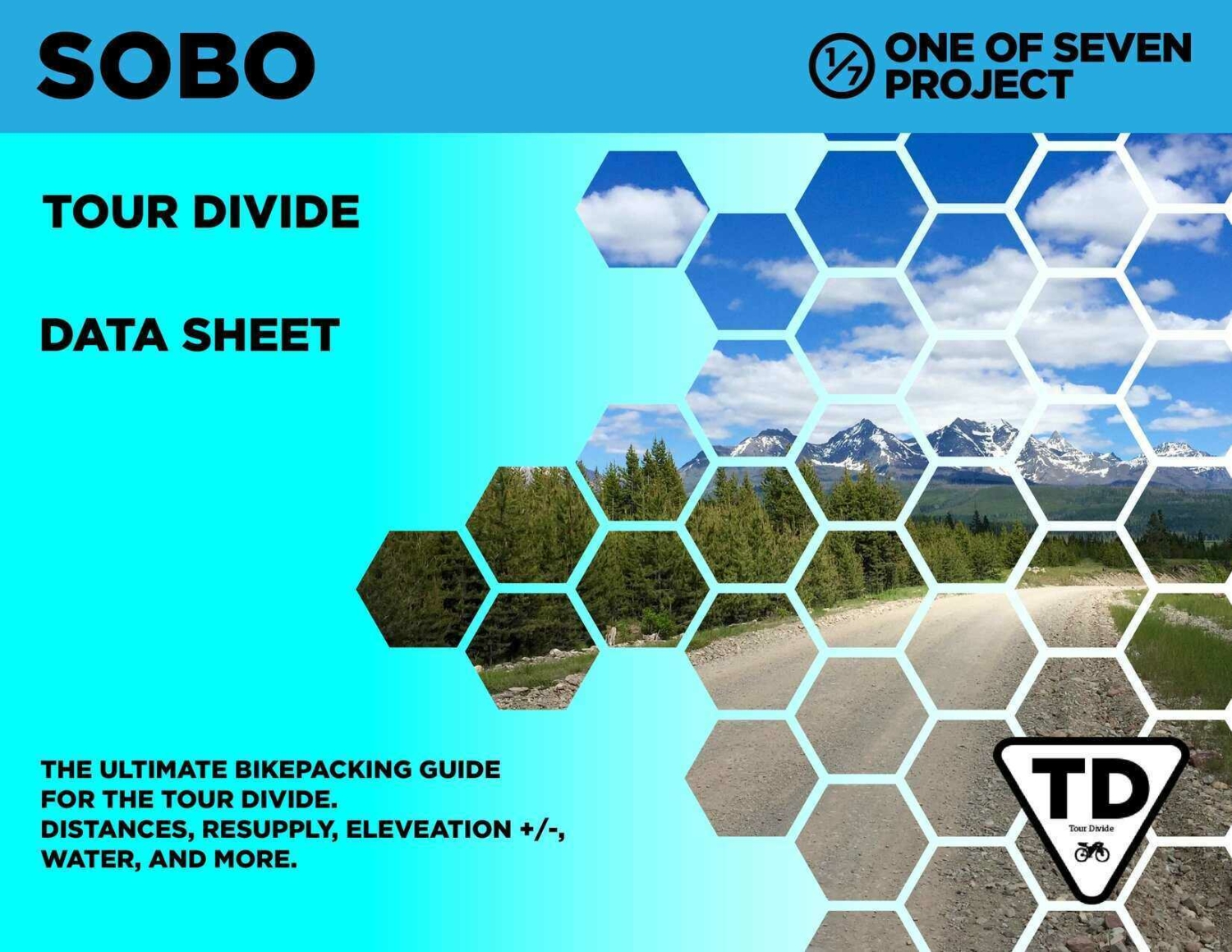
The NOBO Data Sheets are ONLY available as part of the Small or Big Bundles.
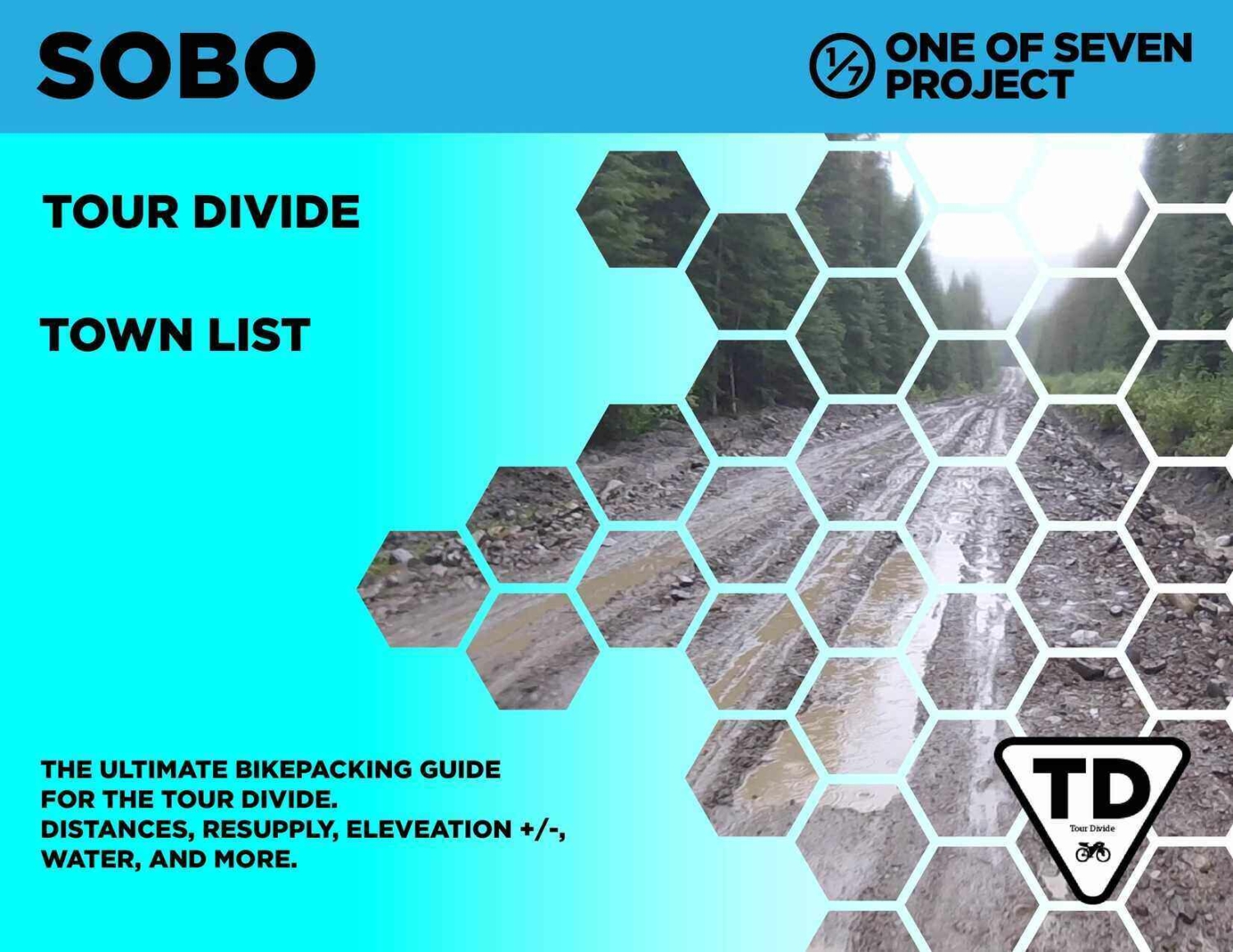
All versions of the Town Lists are ONLY available as part of the Small or Big Bundles.
- Elevation / Pop of POI.
- Mileage numbers.
- Distance to next.
- Elevation +/-.
- Max & Min. elevation between POI.
- Pavement sections.
- Key water sources.
- Shows bike shops.
- Resupply options.
- Important notes.
- Elevation profile.
- Finish Target Times.
- Distance on/off trail.
- Important notes about POI.
- Cumulative distances to up coming POI.
- Elevation Gain to reach up coming POI.
- Finish Target Times added.
The SOBO Data Sheets are available in BOTH US Standard and Metric units.
Data Sheet – $25 + Tax (CO only)
Example of Data Sheet
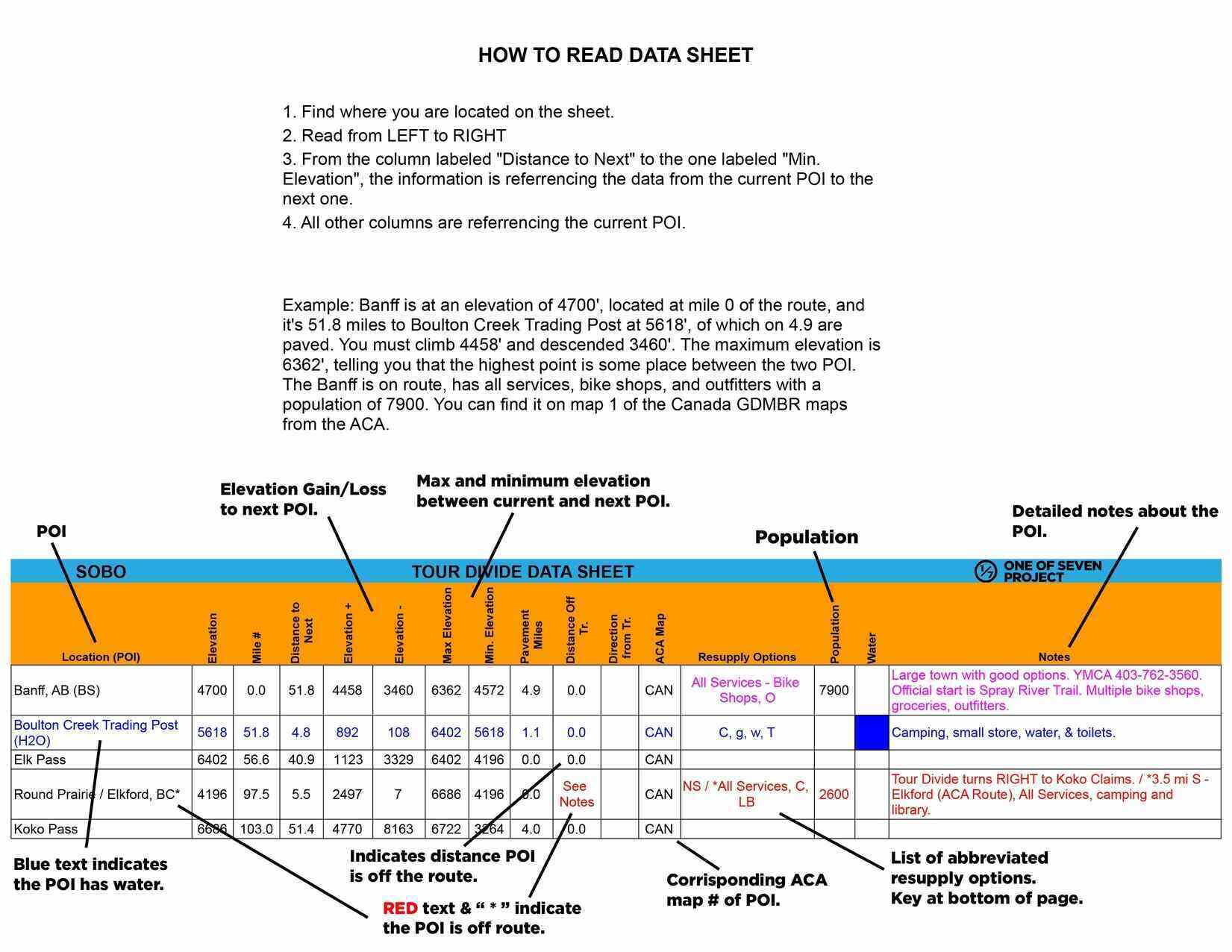
Example of Town List
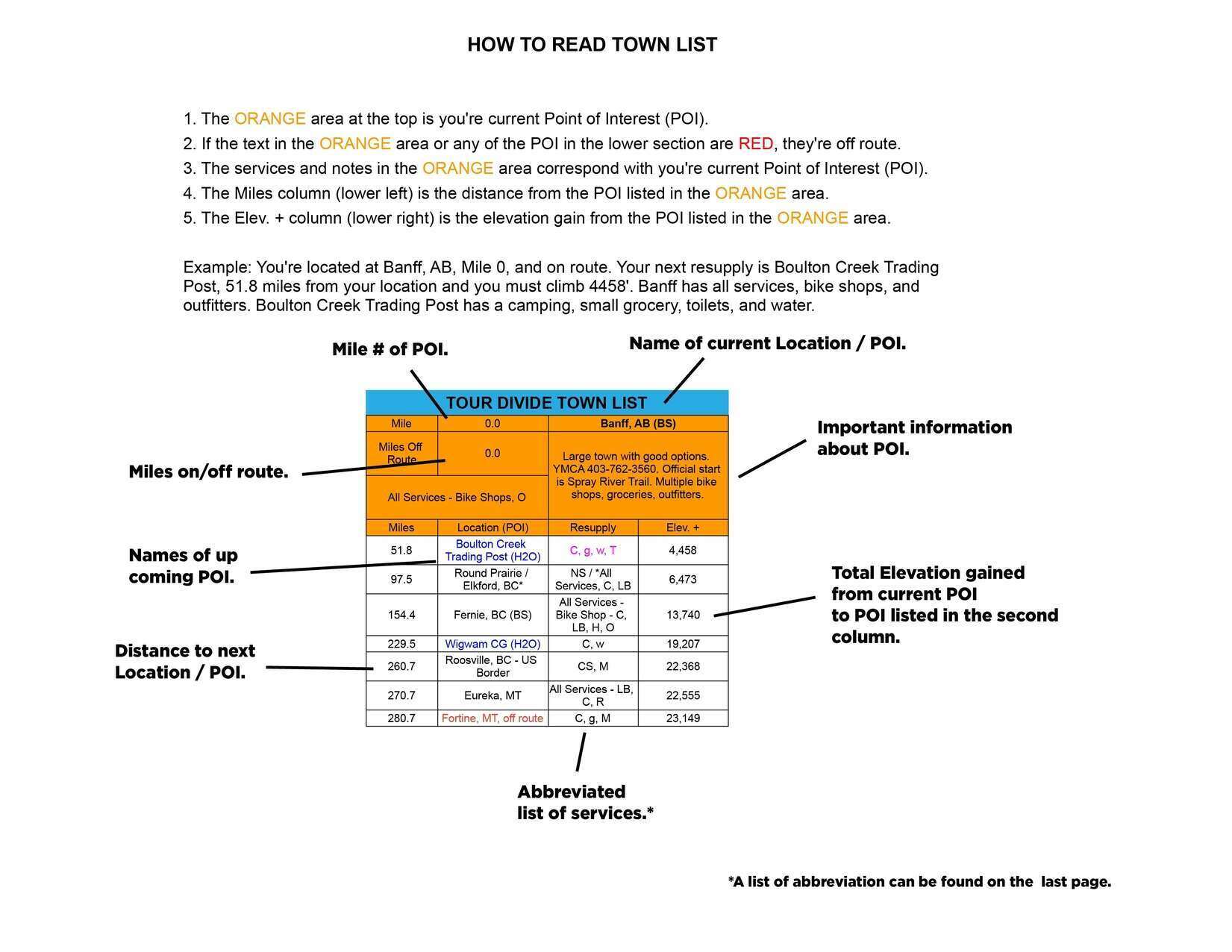
DATA SHEET and TOWN LIST DIFFERENCES
The Data Sheet has the most info. It gives the distance, elevation +/-, average grade, maximum and minimum elevations, pavement sections, references ACA maps, bike shops, resupply options, and has key notes between two POI. Example: A and B, then B to C, and so on.
The Town List gives cumulative distances between POI. Example: A to B, A to C, A to D. The next section would be B to C, B to D, B to E, and so on. The Town List has distance, elevation +/-, resupply options, bike shops and key notes.
The Town List helps with not having to do the math to figure out how far away things are if they’re not the next POI.
Mileage Charts and Elevation Gain Charts
Mileage charts:, elevation gain charts:.
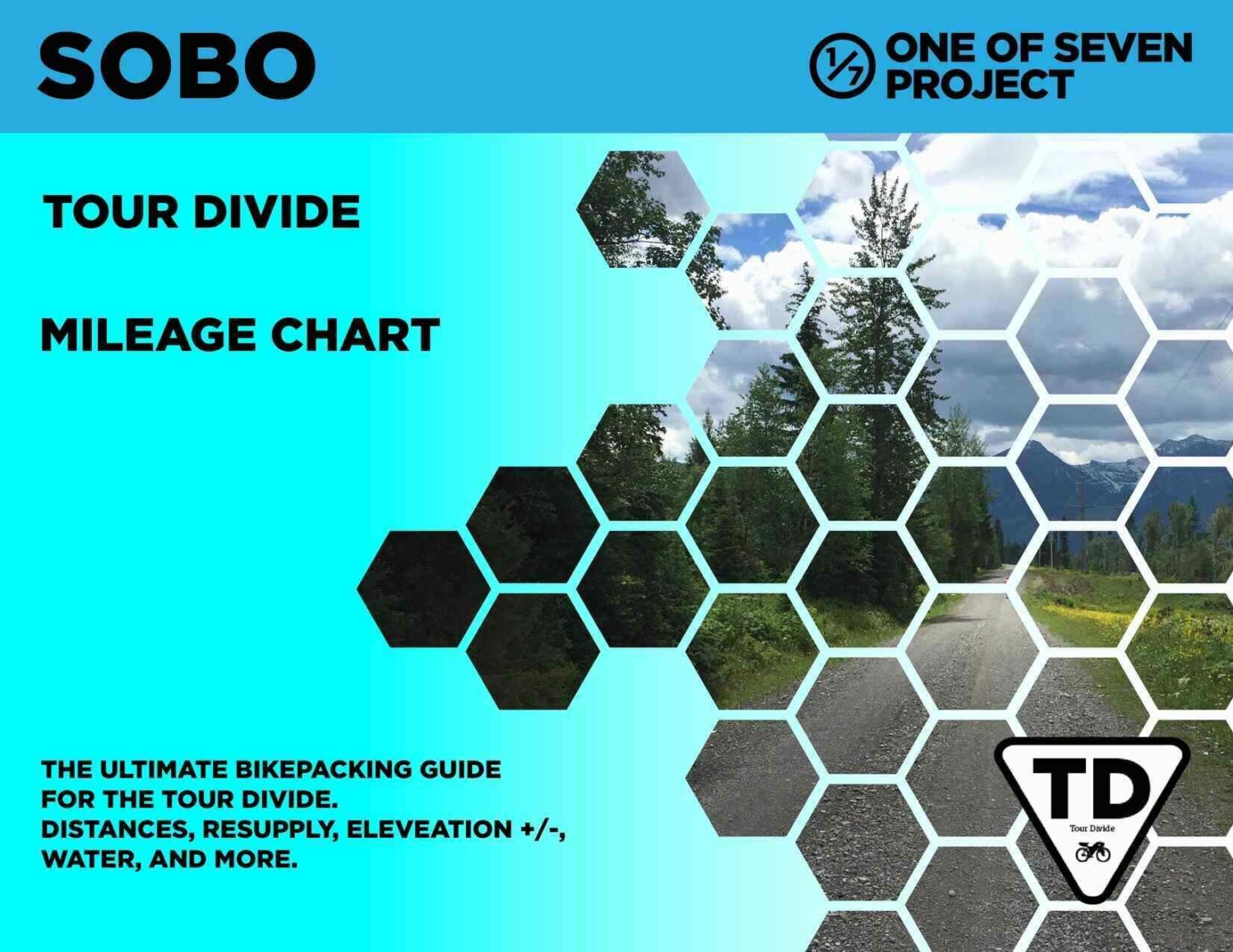
Quickly find the total mileage between any two POI along the route.
- Works for both directions.
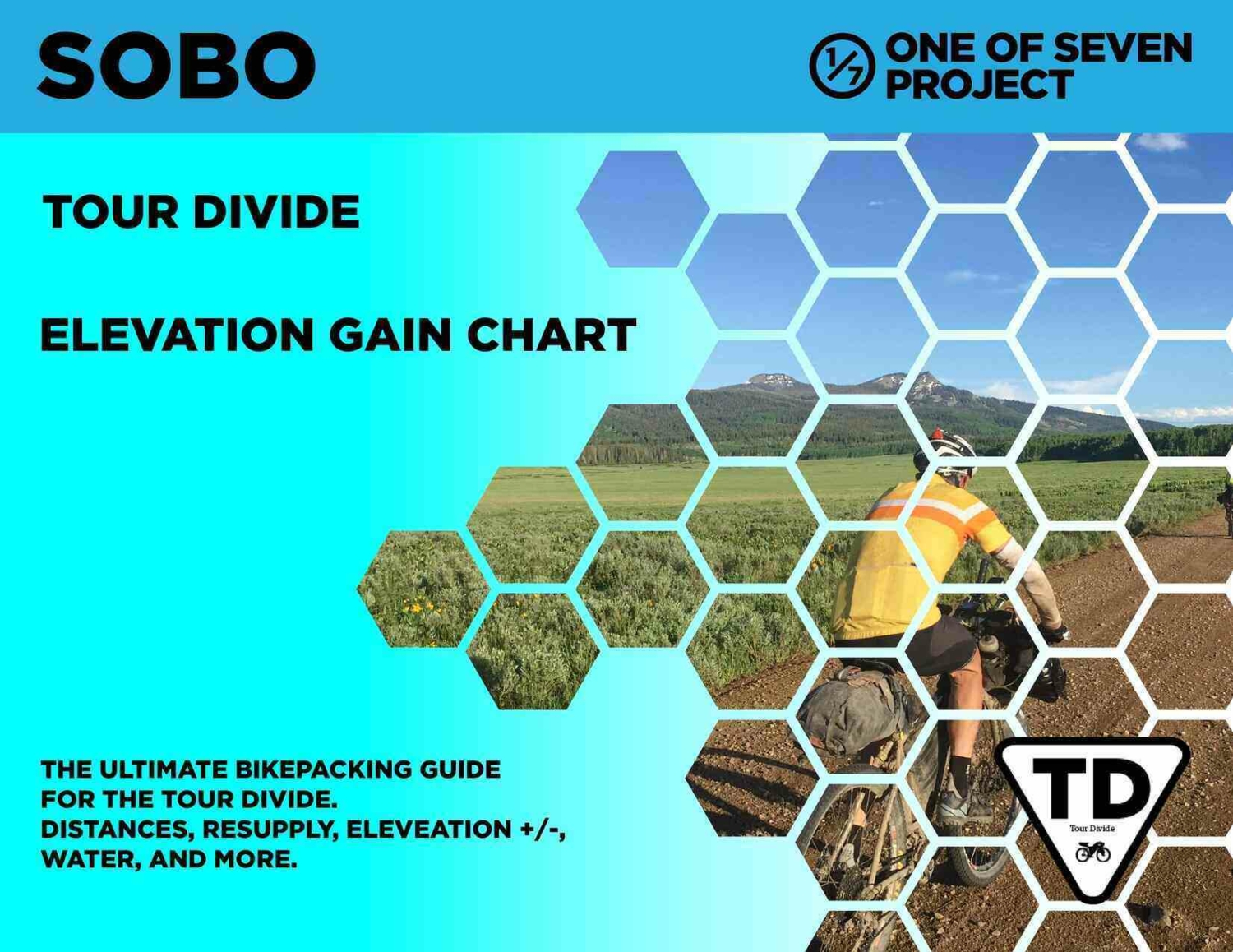
Quickly find the total elevation gain between any two POI along the route.
- Easy to read format.
The Mileage and Elevation Gain Charts are ONLY available as part of the Big Bundle.

GDMBR / ACA ROUTE
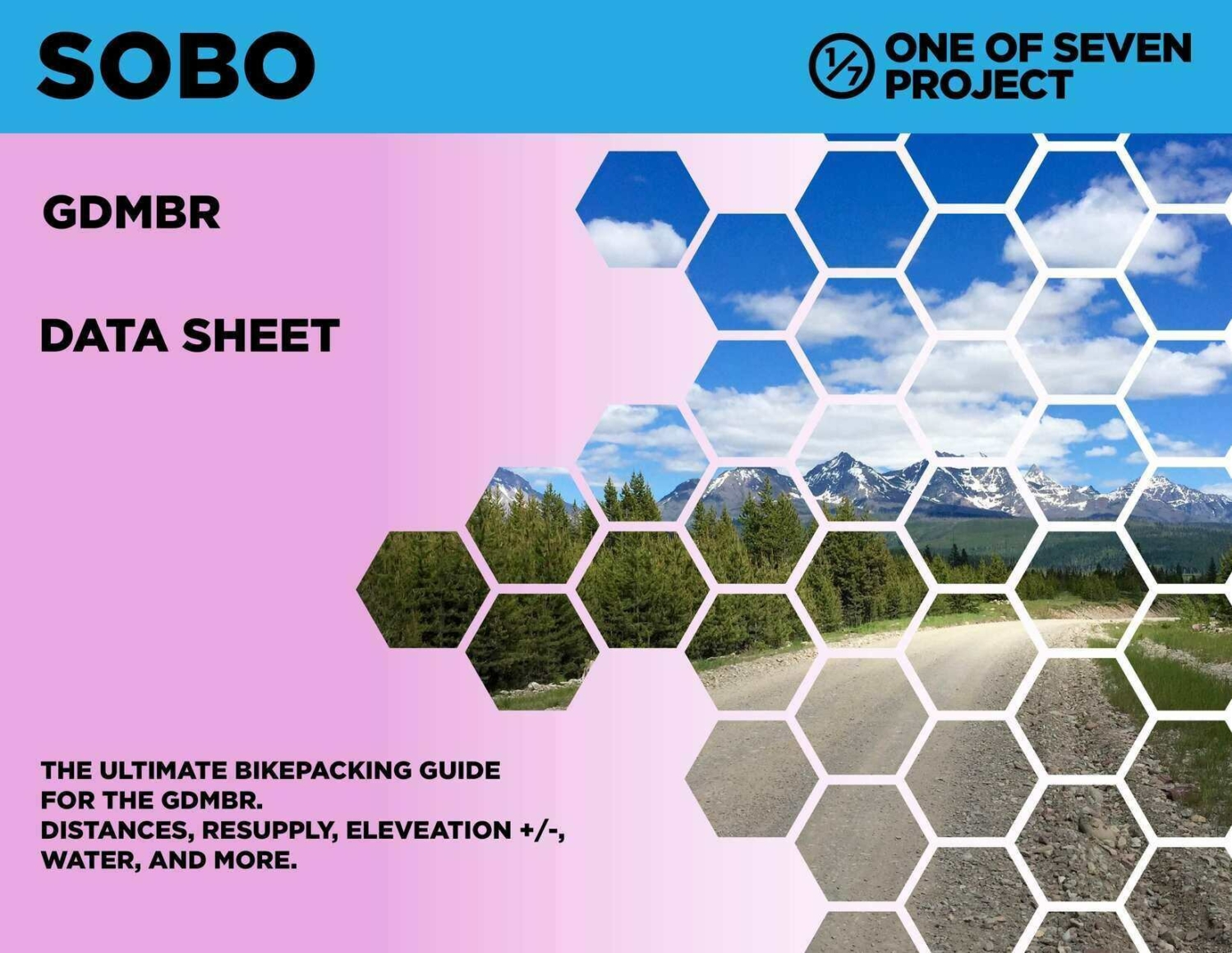
GDMBR Data Sheets have all the same data categories as the Tour Divide planning aids, as seen in the examples above but are for the GDMBR from the ACA.
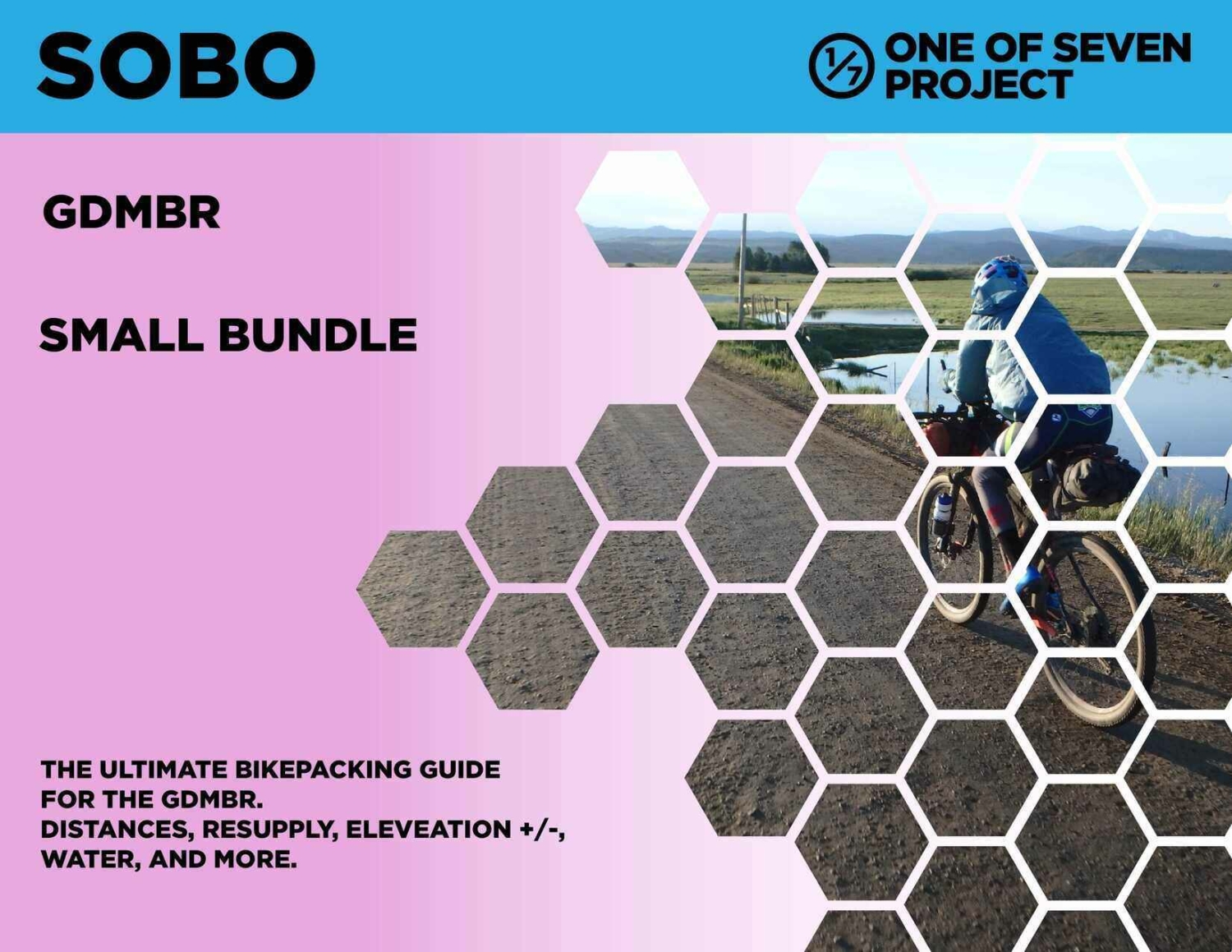
GDMBR Bundles have all the same data categories as the Tour Divide planning aids, as seen in the examples above but are for the GDMBR from the ACA.
Available in both SOBO and NOBO versions and in US Standard and Metric units.
Data Sheet – $25 + tax (CO only)
- The diversity of the route has to be one of the biggest highlights of them all. From the Canadian Rockies, to the Great Basin, to the Rocky Mountains, and finally the deserts of New Mexico you see it all.
- The support from the communities you go through is pretty amazing. Don’t pass up on their hospitality and remember to be polite.
- Some of the top highlights have to be the Flathead Valley in Alberta, Grand Teton National Park and the Great Divide Basin in Wyoming, Boreas and Indiana Pass (the routes highest point at 11,913′) in Colorado, Polvadera Mesa, and the Gila Wilderness in New Mexico.
- The long days and hours in the saddle can get boring. As a result they will test you both mentally and physically. Be ready to be inside your head a lot.
- Limiting your time in town gets harder as you move further along the route. Fighting that voice that say’s “Just one more soda!” or “Just a few more minutes rest.”, can be hard to silence.
- The weather is unpredictable due to the route’s nature. Be ready for all types of weather from rain, snow, hail, wind, lightening and heat.
- There are some segments between towns that are longer than most but none are unmanageable if you have the right bag set up.
- The only two places where water was an issue was the Great Basin and Beaverhead area in NM.
- Camping along the Tour Divide is not hard to find. There are plenty of primitive and developed options for camping, hotels, or lodges on the route.
- There are no areas that require special permits but do be careful to respect no trespassing signs along the route.
- Those touring want to checkout Warmshowers.com .
DANGERS & PITFALLS
- Extreme weather.
- Bears (Grizzly and Black)
- Remoteness of route.
- Lack of water.
- Strenuous terrain.
- Costs can add up.
- Hypothermia
- Riding on roads at night.
- Mental & physical fatigue.
- International border crossing.
PHOTOS OF THE TOUR DIVIDE

EXTERNAL RESOURCES
- BIKEPACKING.NET
- BIKEPACKING.COM
- TOURDIVIDE.ORG
- TRACKLEADERS.COM
- BIKEPACKING.NET FORUM
- FACEBOOK GROUP – Gear, Advice, Tips, Pics, Chat, Training
- FACEBOOK GROUP – 2024 Tour Divide Training & Preparation
- FACEBOOK GROUP – Crazy Larry’s Questions and Answers Session
- FACEBOOK GROUP – Great Divide Mountain Bike Route – Trail Info & Rider Stories
- MTBCAST.COM
MAPS / BOOKS / APPS
- ACA Maps (These maps differ slightly from the official race route, follow your GPS)
- Temporary Closures
- Book – Just Ride
- Book – Cycling the Great Divide
- Book – A Dream Worth Living
- Video – Ride the Divide
- Book – Eat, Sleep, Ride
- Book – Dividing the Great
More Helpful TD Resources
Everything you need to plan a bikepacking trip on the Tour Divide.
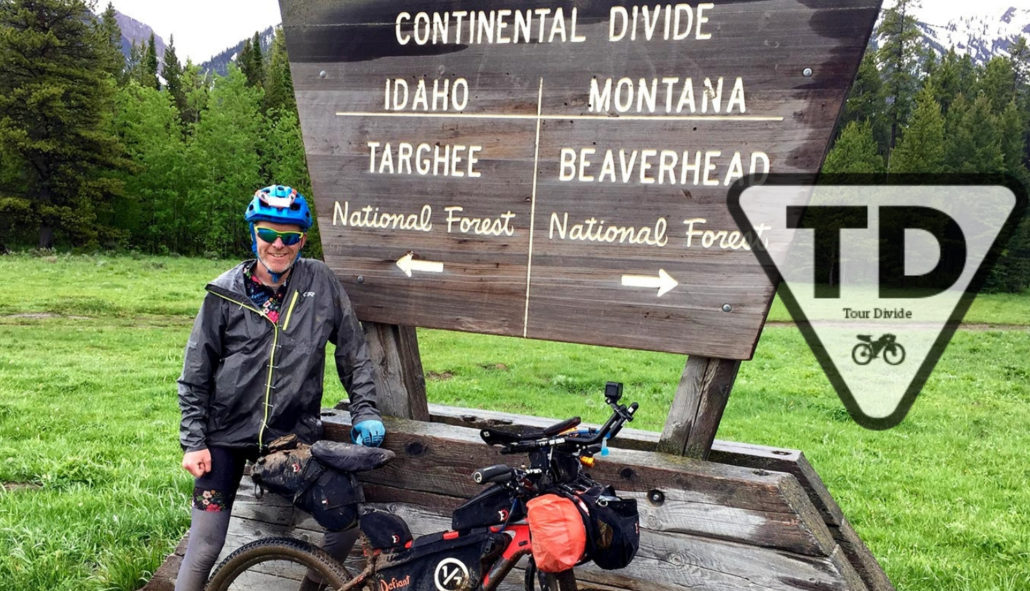
Slide Title
Tour divide guide bikepacking.
Your ultimate bikepacking guide to the Tour Divide.
MY PROVEN GEAR LISTS FROM THE TRIPLE CROWN
Tour divide.
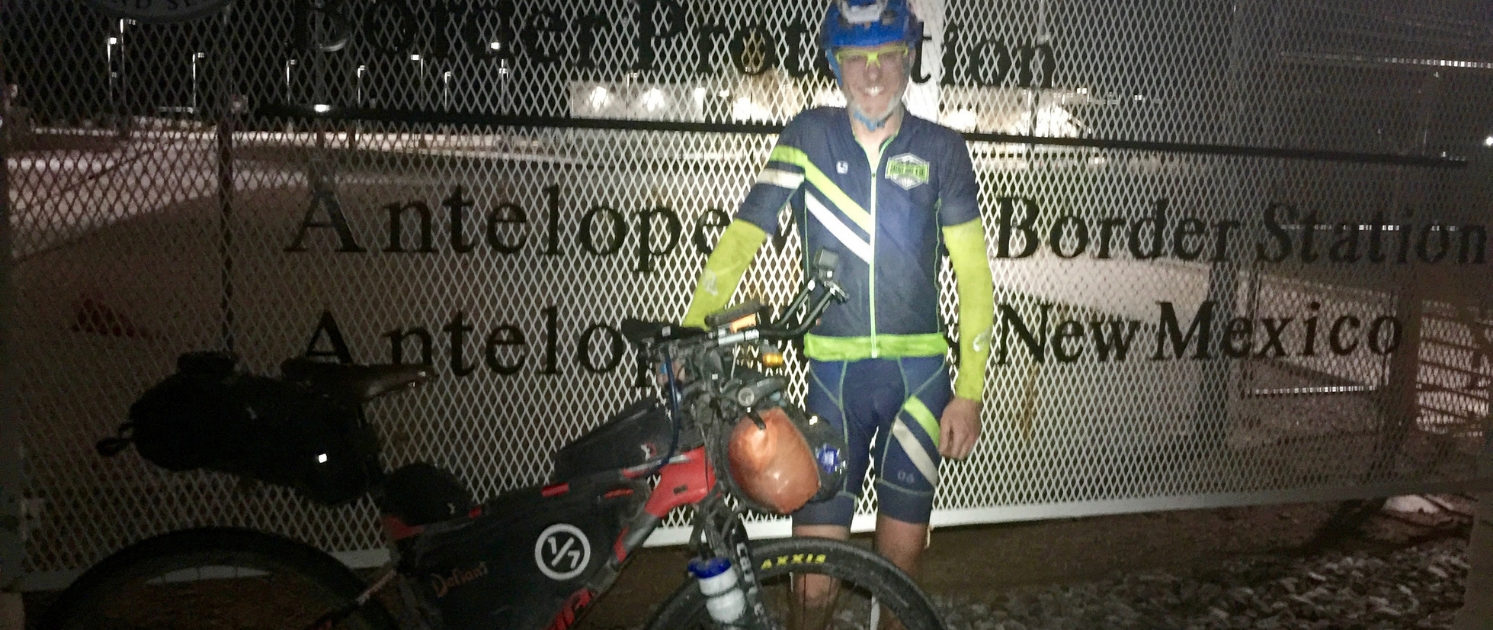
A detailed look at what I used on the Tour Divide, what worked and what didn’t.
“ IF I RODE… ” SERIES
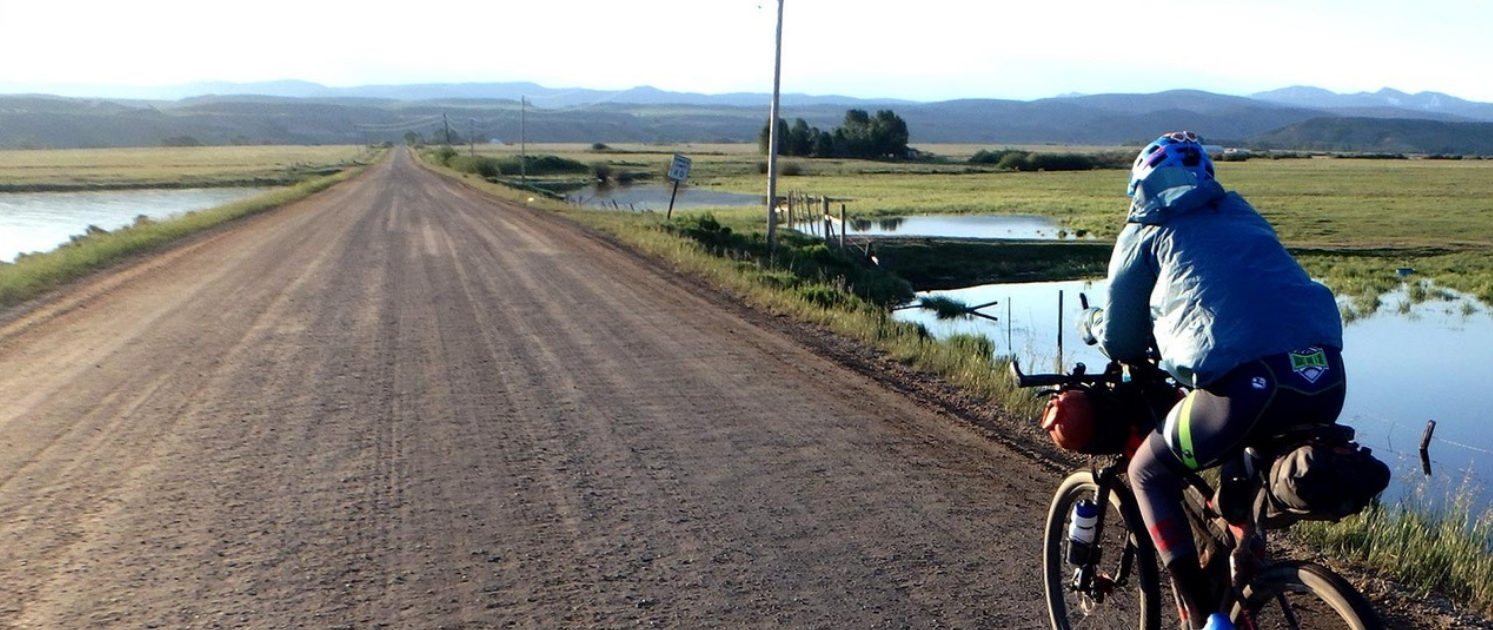
In depth look at what I would bring for gear and why, if I rode the Tour Divide again.
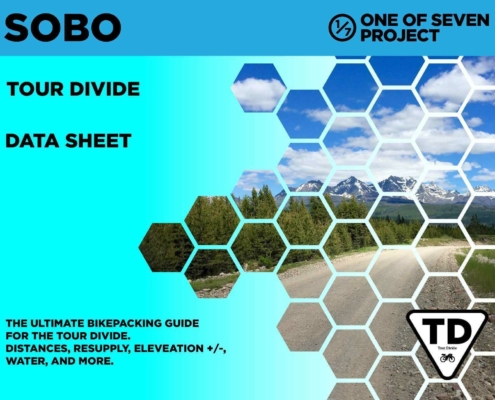
Gear Review - If I Rode The Tour Divide Again
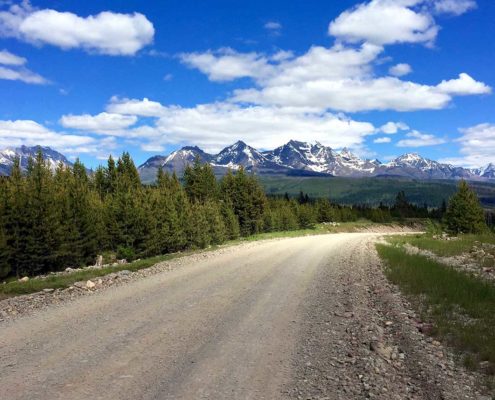
Tour Divide Planning Guide
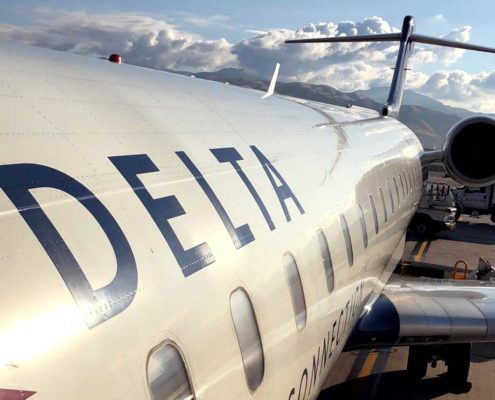
Tour Divide Transportation Guide
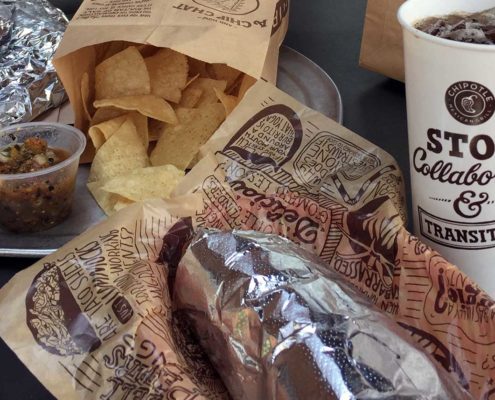
Tour Divide Resupply Guide
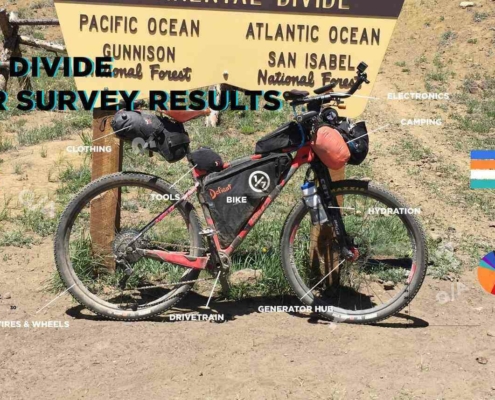
Tour Divide Rider Survey Results
Checkout our bikepacking resource page for more planning help., checkout all our guides.
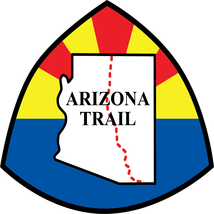
Support the Project
Simply clicking on the links below with our affiliates supports the Project.
Or checkout our Deals page to save big!

Our Thoughts on Getting Outside
Leave no trace principles, recreate responsibly.
Welcome to Escape Collective. Please select your language.
Please note that this is an automated translation and it will not be perfect. All articles have been written in English and if anything appears to not make sense, please double check in English.

How the Tour Divide was won
Rookies ruled the top three spots overall, but weather and other challenges stymied attempts at course records.
Ulrich Bartholmoes closes in on the finish in Antelope Wells after 14 days on the route. Photo © Patrick Farnsworth / Bikes or Death
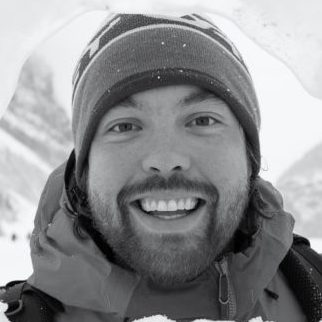
A first-time Tour Divide participant narrowly missed setting the race’s course record last week, while the final spot on the women’s podium came down to an almost-sprint after more than 18 days of racing. Those were just two of the highlights from bikepacking’s signature event.
Measuring 2,685 miles/ 4,321 km long while crisscrossing the Continental Divide 30 times between Banff, Alberta, and Antelope Wells, New Mexico, the Tour Divide is notoriously hard. Preparing for the event can take years; however, chasing Tour Divide records isn’t just about preparation.
“I stated it clearly beforehand,” said men’s winner Ulrich Bartholmoes, “that I came here to take the win and the record. But I was also realistic. I was well aware that 20% of this was in my control and 80% depended on external conditions or what the trail wanted to allow me to do.”
And when things kicked off in Banff, on June 9, 2023, conditions felt prime for a fast edition. The start list included notable course veterans and recordholders like Lael Wilcox and Alexandera Houchin alongside Tour Divide rookies Bartholmoes, Justinas Leveika, Jens Van Roost, and WorldTour pros turned gravel privateers Ted King and Alex Howes.
As the race crossed Montana, Idaho and Wyoming, it looked like new records were inevitable. Bartholmoes, Van Roost, and Leveika outpaced Mike Hall’s course record, set in 2016, significantly. But the traverse across the Great Divide Basin between Atlantic City and Wamsutter quickly upended any expectations. Wet conditions ground the three leaders to a standstill, peanut butter mud clogging their drivetrains and impeding progress. It took the trio nearly 24 hours to complete that 100-mile section and they fell hours behind Hall’s pace. Just 24 hours later, eventual fourth-place finisher Steven Le Hyaric would cross the same ground in just nine hours as it dried out.
The three race leaders played leapfrog throughout Colorado. While they rarely rode together, they watched each other closely while riding their own paces.
“It was surprising to me that we stuck together for such a long time,” said Bartholmoes. “I’ve never had this and it affected the race. At some points, it felt like a group ride.”
By Salida, Colorado, Van Roost had fallen behind the pace and he scratched before Del Norte with intolerable and soon-to-be unsafe nerve damage to his hands because he could barely grip his handlebars. He wasn’t alone; 69 riders have scratched, including King, who suffered rhabdomyolysis, Sarah Swallow, and John and Mira, the human-canine pair we highlighted in The Tour Divide is Bikepacking at its Best .
Bartholmoes and Leveika continued to battle for the win, but by Cuba, New Mexico, Bartholmoes put in a big push to temporarily catch Hall’s record dot on Trackleaders and held the lead through to the finish. His overall time, 14 days, 3 hours, 23 minutes, is the second-fastest Tour Divide time, trailing just 4.5 hours behind Hall. Leveika finished second, thirteen hours later and Joe Nation completed the men’s podium early the following day.
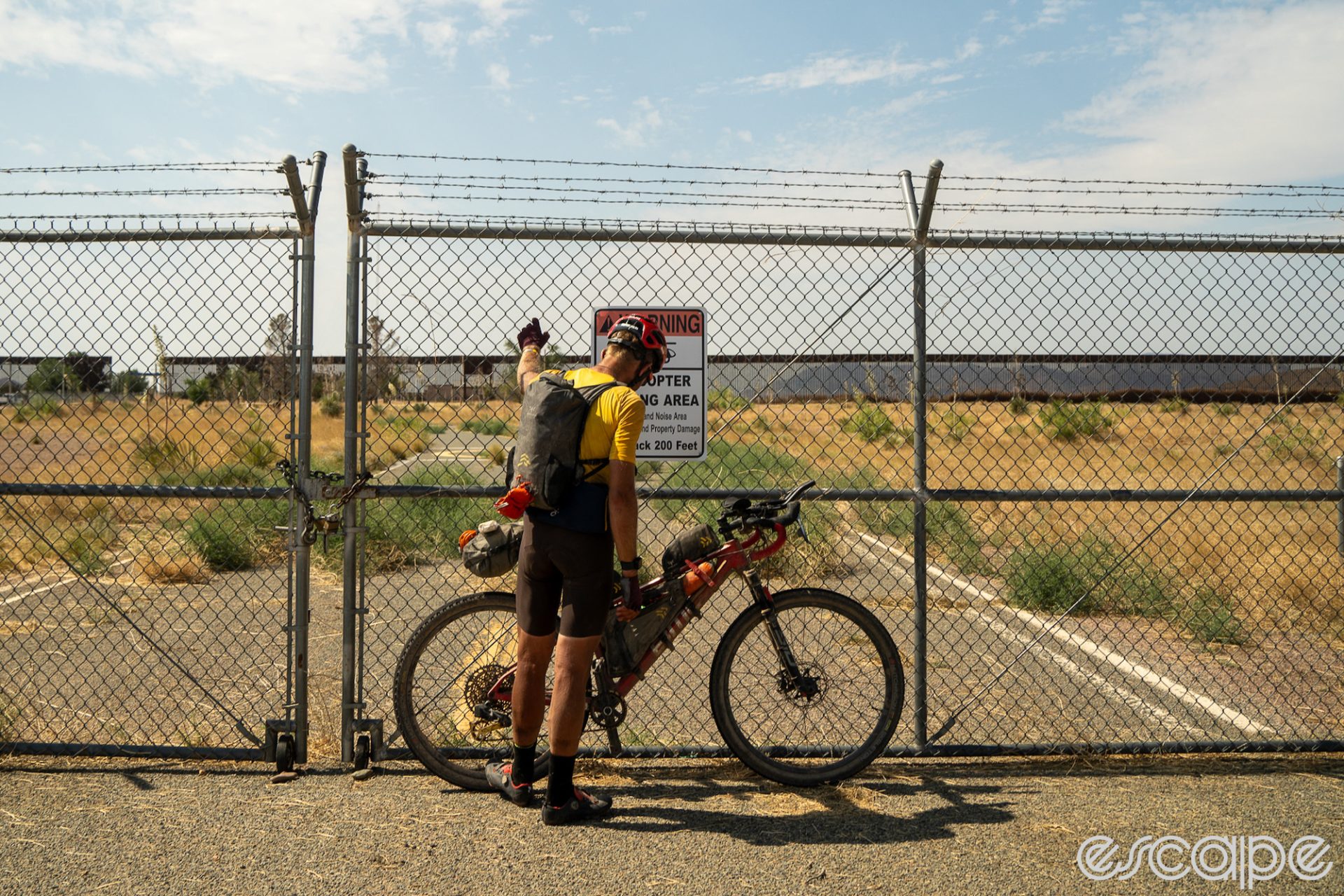
“I’m just happy with my time and my entire ride,” said Bartholmoes. “I never met Mike, but people that I talked to say he loved competition and I love competition. Just trying to chase his dot throughout this race makes me proud that I could keep up with him. That’s enough for me.”
The women’s podium race played out similarly. Wilcox started strongly, outpacing her 2015 dot before slowly falling off record pace. She cited both route conditions and physical setbacks, and the race clearly took its toll. Illness and dehydration forced her to visit a health clinic in Abiquiu, New Mexico, where she received an IV to replenish lost fluids. She continued and held on for her first official Tour Divide victory. Although she finished first in 2015, she was credited with the record rather than the win because of a course deviation. She set the current course record that same year, during an individual time trial.
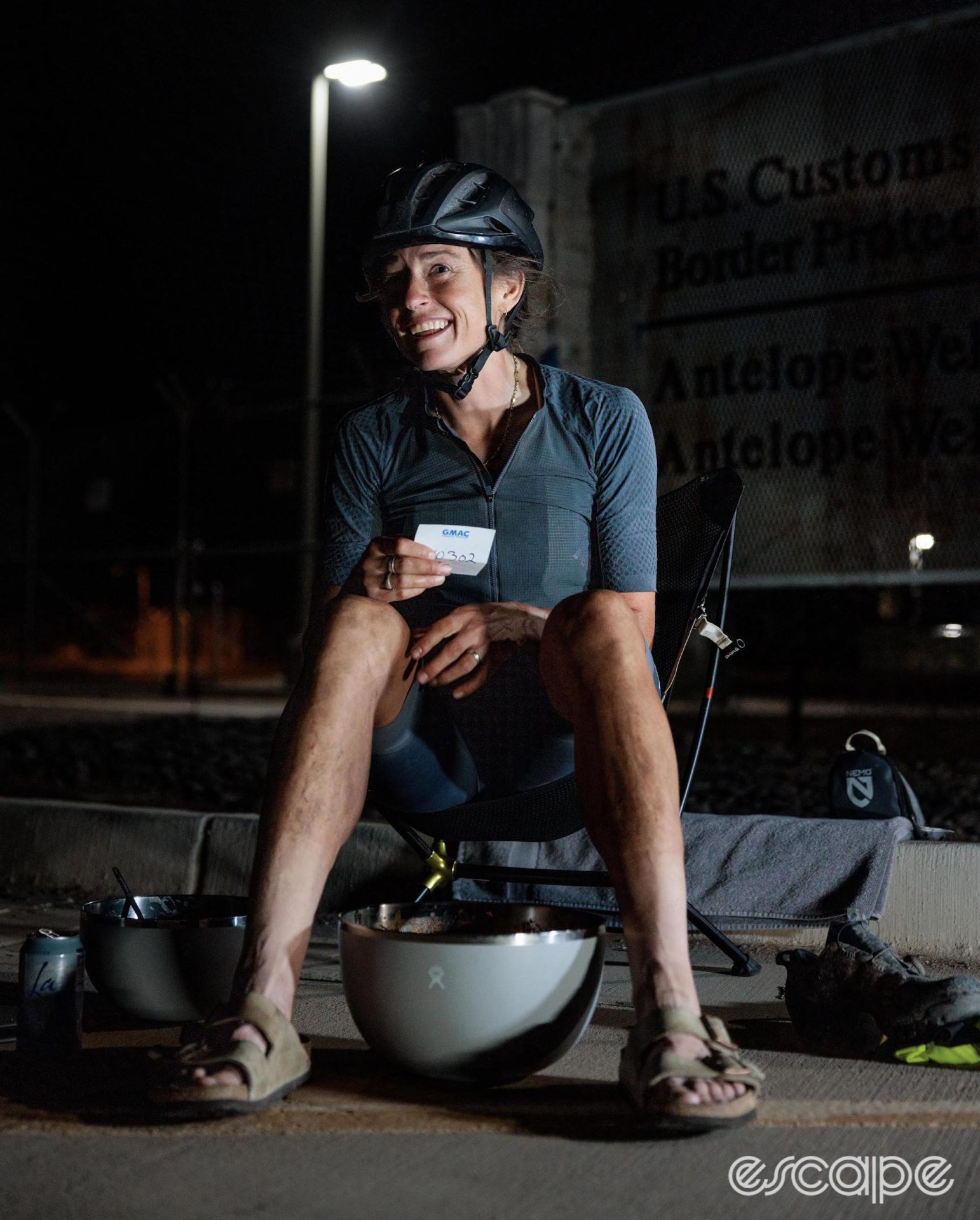
Katya Rakhmatulina completed a strong ride to finish second. The closest battle proved to be for third place in the women’s field. Sasha Dowell and Hannah Simon left Silver City together with Gail Brown trailing by just a few miles. Simon and Dowell rode the final miles side by side and decided to finish together, tied for third, rather than sprint it out. Brown finished just 15 minutes later. Houchin finished later the same evening, lowering her own singlespeed record by two hours.
Although the race leaders have finished and traveled home, the Tour Divide isn’t over. More than 100 competitors continue their race and the broom wagons – set at 95 miles per day for men and 85 miles per day for women on Trackleaders – are still in Colorado, nearly 1,000 miles from the finish line. For the next week, official finishers will trickle into Antelope Wells. Their experiences will be unique, but they’ll share similarities.
“It felt surreal,” said Nation, reflecting on his third-place finish. “Riding south from Hachita is so different from the rest of the route. It was just a slow, slightly uphill grind. It gave me lots of opportunities to think.”
For the past fifteen days, he shared a few moments with fellow competitors, like Chris Burkard and Ezra Ward-Packard, but estimates he rode solo 90% of the time. From surprise grizzly bear encounters to bike-stopping mud, the ride felt like a series of highs and lows. He’d forced himself to avoid getting caught up in the race and stuck to his plan to average 300 km and 4-5 hours sleep per day through the first week. By the second week, he started sacrificing sleep and shortening his resupply points.
“I would try once a day to get a 1500-calorie meal in,” he said. “I was loving the American-style burgers and chips. The rest of the time, I was thinking about resupply, the bike, and logistics.”
On the final stretch of pavement, there was nothing left to worry about.
“All of that was suddenly gone,” he said, “ and I could just tap myself on the back. There were a few emotions, for sure, and the fence couldn’t come fast enough.”
Course Records (days:hours:minutes):
- Men’s overall: Mike Hall (2016): 13:22:51
- Men’s singlespeed: Chris Plesko (2016) 15:08:01
- Women’s overall: Lael Wilcox (2015) 15:10:59
- Women’s singlespeed: Alexandera Houchin (2023) 18:18:26
2023 Results:
Men’s Overall
- Ulrich Bartholmoes 14:03:23
- Justinas Leveika 14:16:57
- Joe Nation 15:02:50
Women’s Overall
- Lael Wilcox 16:20:00
- Katya Rakhmatulina 17:08:48
- (tie) Hannah Simon and Sacha Dowell 18:11:13
Men’s Singlespeed
- Kyle Peterson 16:22:28
- Jake Colantonio 17:22:58
Women’s Singlespeed
- Alexandera Houchin: 18:18:26
What did you think of this story?
😐 Meh 😊️ Solid 🤩 Excellent
Read Comments
escapecollective
- the Route (description)
- The Challenge
- Grand Départ
- Rider Resources
- News & Notes (blog)
- News & Notes
- `11 Race Updates
- `11 Rider Call-Ins
- `11 ITTD Updates
- `10 Race Updates
- `10 ITTD Updates
- `09 Race Updates
- `09 ITTD Updates
- `08 Race Updates
- About Start List
- `11 TD Start List
- `11 ITT-D Start List
- `11 Letters of Intent
- `10 TD Start List
- `10 Letters of Intent
- Start List & LOI Archive
New Mexico Photos
- See All Photos from the album "New Mexico Photos"
- Pinkbike.com
- Register New User
- First Looks
- Friday Fails
- Community Blogs
- Fantasy League DH
- Places Directory
Photo Report: Pedal Through the Pain - Tour Divide 2019
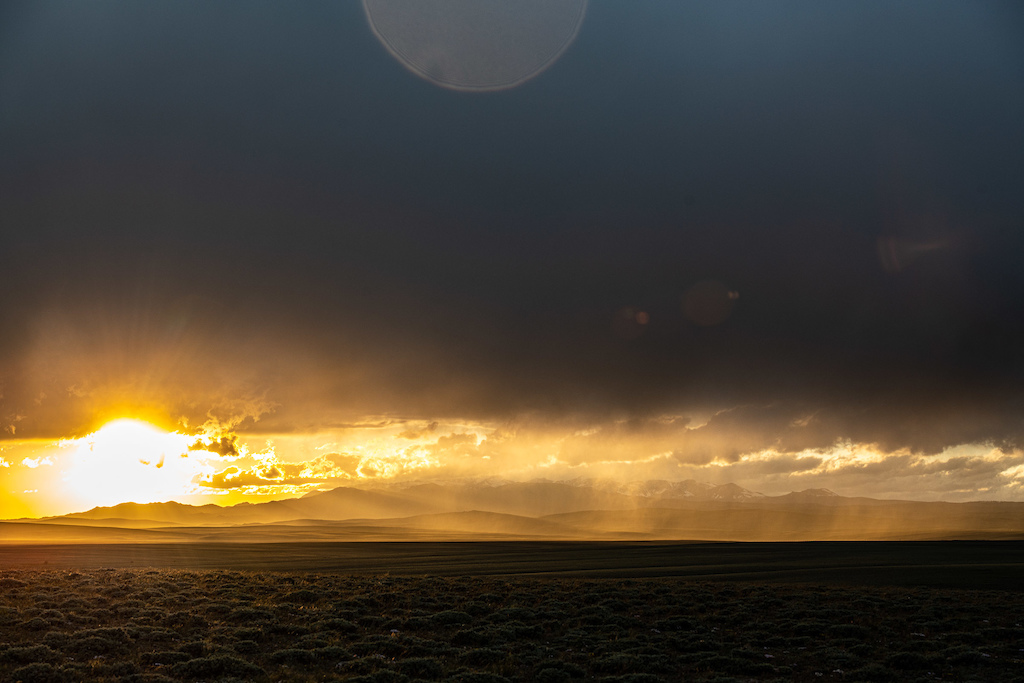
Cool Features
SORT CONTENT BY LOCATION
CLICK TO DRILL DOWN BY COUNTRY/PROVINCE
Your browser is ancient! Upgrade to a different browser or install Google Chrome Frame to experience this site.
Inspiration
- Bikepacking 101
- Join/Support

- View Latest/All
- Bikepacking Videos
- Your Stories
- Rider's Lens
- Field Trips
Popular Tags
- #bikerafting
- #Tour-Divide
- #family-bikepacking
- #winter-bikepacking
- #1Q5V (1 Question 5 Voices)
Gear/Reviews
- Bikepacking Bags
- Camping Gear
- Accessories
- #Editors-Dozen (Our Favorite Gear)
- #Gear-of-the-Year
- #MYOBG (DIY)
- #Decade-in-Review (Best of All Time)
The Gear Index
Latest indexes.
- Mini Panniers
- Saddlebags & Top Openers
- Cargo Cages & Anything Bags
- Gravel Bars
- Drop Bar 29ers
Bikepacking Bikes
- Rigid & Plus Bikes
- Drop-bar & Gravel
- Full Suspension
Rigs & Roundups
- Rider & Rig
- Race/Event Rig Roundups
- Worthy Builds
- Handbuilt Bikes
- #29+ (29-plus)
- #vintage-mountain-bikes
- #cargo-bikes
- Readers' Rigs (Dispatch)
- New Bikes (Dispatch)
Plan Your Trip
- Bikepacking Guides
- Bikepacking Food
- Gear & Pack Lists
- Bike Photography
Essential Reading
- Leave No Trace (for Bikepackers)
- Guide To Bikepacking Bags
- Bikepacking Gear That Lasts
- #Bikepacking-Awards
- Power Of An Overnighter
- Advice For New Bikepackers
- Our Favorite Bikepacking Routes
-
Where to Begin
We have over 300 original and curated bikepacking routes in our global network spanning nearly 50 countries.

Start at our worldwide routes map to dig into our detailed guides with GPS maps and inspiring photography.
By Location
- The United States
- Latin America
- Middle East
By Length (days)
- Overnighters & S24O
- Weekend Routes (2-4)
- Week-long Routes (5-10)
- Odyssey Routes (11-30)
- "Freakouts" (31+)
Local Overnighters
The Local Overnighters Project is a unified effort to document and map one-night bikepacking routes all over the world—by locals, in their own backyards.
The Bikepacking Journal is our biannual printed publication. Each issue features a collection of inspiring writing and beautiful photography. Find details on the three most recent issues below, join the Bikepacking Collective to get it in the mail (anywhere in the world), or click here to find a collection of selected stories in digital format.

The special edition 10th issue of The Bikepacking Journal is one you won’t want to miss! It features 25% more pages with extra stories, bonus art and maps, and much more...

Issue 09 takes readers on trips through time—one to the early days of bicycles—and offers several reminders to be grateful for supportive friends and family, and strangers we meet along the way...

For Issue 08, we invited several contributors to return and pick up where earlier trips and ideas left off and also feature a handful of first-timers whose perspectives we’ve long been eager to share...

- Bikepacking Races
2021 Tour Divide
June 11, 2021 @ 12:00 pm - july 1, 2021 @ 12:00 pm, alberta, canada 2745mi (4,418km).
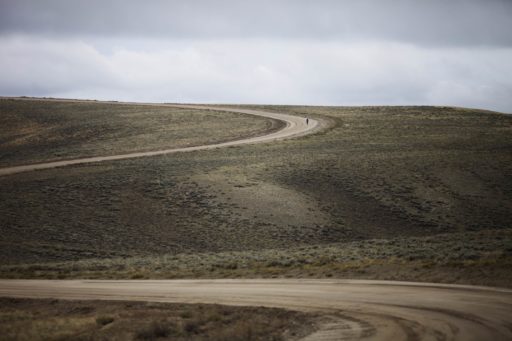
Next Event Sat Dec 23, 2017
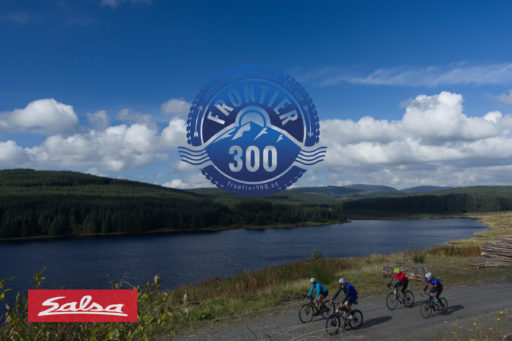
Next Event:
Frontier 300 (2021)
After a year hiatus, the 2021 Tour Divide is on, albeit slightly different. This year’s event follows the length of the Great Divide Mountain Bike Route for ~2,450 miles from the Canada border to Antelope Wells, New Mexico. Follow the race on the tracker map here.
Start: June 11, 2021 @ 12:00 pm
End: July 1, 2021 @ 12:00 pm
Event Website
Tour Divide Grand Depart
Banff , Alberta Canada
With regional COVID-19 restrictions changing every day and the border closure between the US and Canada extended, there was official announcement on what this year’s Tour Divide will look like. In short, the 2021 Tour Divide will start from Eureka, Montana at the Canada border and run for nearly 2,500 miles to the traditional southern terminus at Antelope Wells on the Mexican border. Read more here. Also, you can follow this years ~100 grand depart participants on the Trackleaders map below.
The Tour Divide roughly follows the Great Divide Mountain Bike Route (GDMBR) is the most recognized and important off-pavement cycling route in the United States, if not the world. The route crisscrosses the Continental Divide from north to south starting in Banff, Alberta, Canada and finishing at the US/Mexico border in Antelope Wells, New Mexico.
Time-trial season on the GDMBR begins annually with Grand Départ, occurring on the second Friday in June from both termini of the Route; the main Depart takes place in Bannf, Alberta. The Tour Divide see hundreds of riders each year, with the goal of these Solstice common starts is for athletes to challenge the Route in situ, under similar weather conditions and maximum daylight. If one cannot make a grand départ, there is a season-long ITT-Divide format to contend. Tour Divide requires no entry fee or formal registration. There are no prizes for finishing. Riders who carry SPOT GPS Messengers are tracked via the Live tracker.
For more on the Great Divide Mountain Bike Route, check out our guide, here . Also, find the Rigs of the 2019 Tour Divide here , and check out #tour-divide for many more articles and resources.
Registration: Send a letter of intent after winter solstice to [email protected] .
Event image by Matt & Brett, A View From Two Wheels.

Rad Companies that Support Bikepacking

You need to be logged in to use these features. Click here to login , or start an account if you’re not yet a member of the Bikepacking Collective…

IMAGES
VIDEO
COMMENTS
The Great Divide Route is the world's longest off-pavement cycling route. It was tirelessly mapped over a 4 year span, and published in 1998 by Adventure Cycling Association, North America's premiere bicycle travel organization. The route is highlighted by long dirt roads and jeep trails that wend their way through forgotten passes of the ...
The Tour Divide roughly follows the Great Divide Mountain Bike Route (GDMBR) is the most recognized and important off-pavement cycling route in the United States, if not the world. The route crisscrosses the Continental Divide from north to south starting in Banff, Alberta, Canada and finishing at the US/Mexico border in Antelope Wells, New Mexico.
The 2023 Tour Divide begins on Friday, June 9th, at 8 a.m. with around 200 riders following the roughly 2,700-mile Great Divide Mountain Bike Route from north to south starting in Banff, Alberta, Canada, and finishing at the US/Mexico border in Antelope Wells, New Mexico. The current record was set back in 2016 by the late Mike Hall (13 days ...
The northern terminus of the Great Divide Mountain Bike Route (GDMBR) is in Jasper (it was in Banff - the start of the Tour Divide - until 2018), a resort town in Alberta, Canada. It then heads south for over 3,000 mi / 4,800 km to its southern terminus at the US-Mexico Border at Antelope Wells, New Mexico. It can be ridden in either ...
The Great Divide Mountain Bike Route (GDMBR) is the most recognized and important off-pavement cycling route in the United States, if not the world. The route crisscrosses the Continental Divide from north to south starting in Banff, Alberta, Canada and finishing at the US/Mexico border in Antelope Wells, New Mexico.
The Grand Tour of MTB Banff, AB CA - Antelope Wells, NM USA Expedition Bike Racing at it's finest Great Divide Mountain Bike Route One Stage: 2745mi / 4418km Self-Supported Racing Great Continental Divide Mountain Bike Race 13th of June, 2014.
Welcome to my daily coverage of the 2023 Tour Divide. The Tour Divide is a 2700mile bikepacking race traversing the length of the USA. The Tour Divide starts...
As riders prepare for the 2023 Tour Divide Grand Depart, Mitchell Connell reflects on his time riding a section of the Divide with Baker Donahue and Will Reynolds, who were headed north from Antelope Wells, NM to Banff, Alberta. In this clever piece, Mitchell intersperses his retelling of the trip with the riders' "top five" responses to a variety of prompts and, in doing so, distills down the ...
The Tour Divide, a bikepacking race from the Canadian Rockies to the U.S. border with Mexico, has always been a test of fortitude. But extreme weather is making it much more dangerous. Geof Blance ...
New Mexico offers a lot of peaceful riding, but it's also home to several of the roughest and rockiest sections of the entire Divide and long stretches without food and water. Heading northbound, you'll have some of the toughest terrain and longest carries behind you by the time you reach Colorado.
Tour Divide Resource. Tour Divide Guide; Tour Divide Planning Guide; Tour Divide Resupply Guide; Tour Divide Transportation Guide; Tour Divide Planning Aids; ... In New Mexico at the Antelope Wells Port of Entry there is a dirt area on the right, where one can park and wait for riders. The Town of Banff has a 72 hour rule for parked cars.
Ultimate Tour Divide Bike. Markman embarks in mid June on the Tour Divide, an approximately 2,745-mile bicycle tour from Banff to Antelope Wells, New Mexico, along the continental divide through ...
The Tour Divide is an annual mountain biking ride traversing the length of the Rocky Mountains, from Canada to the Mexican border.Following the 2,745-mile (4,418 km) Great Divide Mountain Bike Route, it is an ultra-distance cycling ride that is an extreme test of endurance, self-reliance and mental toughness. The ride format is strictly self-supported, and it is not a stage race - the clock ...
The 2022 Tour Divide begins on Friday, June 10th at 8AM with over 200 riders following the 2,745-mile Great Divide Mountain Bike Route from north to south starting in Banff, Alberta, Canada and finishing at the US/Mexico border in Antelope Wells, New Mexico. The current record was set back in 2016 by the late Mike Hall (13 days, 22 hours, 51 ...
Riding the Great Divide Mountain Bike Route (GDMBR) or racing the Tour Divide is a rite of passage for many bikepackers; it's seen as the "Big One" in North America. Stretching 2,745 miles from Banff, Alberta to Antelope Wells, New Mexico, it loosely follows the Continental Divide through the Rocky Mountains on a series of dirt and paved ...
On August 29 Lachlan Morton set out to take on the Tour Divide route - from Banff in Canada's Rocky Mountains to Antelope Wells in New Mexico - to see just how quickly he could do it even ...
Traveling through the Canadian provinces of Alberta and British Columbia, and the states of Montana, Idaho, Wyoming, Colorado, and New Mexico, the trails covers a wide range of landscapes. The route is based off the GDMBR* (Great Divide Mountain Bike Route) from the Adventure Cycling Association , and took four years to map and was released by ...
Bartholmoes and Leveika continued to battle for the win, but by Cuba, New Mexico, Bartholmoes put in a big push to temporarily catch Hall's record dot on Trackleaders and held the lead through to the finish. His overall time, 14 days, 3 hours, 23 minutes, is the second-fastest Tour Divide time, trailing just 4.5 hours behind Hall.
Photos From New Mexico section GDMBR. See All Photos from the album "New Mexico Photos"
Words & Photography by Eddie Clark. Starting in Banff, Canada and finishing in Antelope Wells, New Mexico at the US border crossing, the 2745 mile (4417 km for the rest of the world) Tour Divide ...
The Tour Divide roughly follows the Great Divide Mountain Bike Route (GDMBR) is the most recognized and important off-pavement cycling route in the United States, if not the world. The route crisscrosses the Continental Divide from north to south starting in Banff, Alberta, Canada and finishing at the US/Mexico border in Antelope Wells, New Mexico.
The event is free at Manzno Mesa Multigenerational Center from 8:30 a.m. to 12:30 p.m. April 19-20 The Show - Albuquerque's longest-running comedy show happens every Friday and Saturday at 9: ...